#as well as 16th century japanese and chinese fashions
Explore tagged Tumblr posts
Text
when i'm comparing 5 different 16th century maps and reading about in depth histories detailing reconstruction during different eras of the louvre palace all for 1 detail in chapter thirty fucking six of this fic, it's time to evaluate if i'm really interested in figuring out the exact configuration of gardens to ballroom or if I'm just trying to avoid actually writing
#i set out looking for photos of like#the rooftops for you know#standard ladybug reasons#but got caught up in finding the ballroom and the gardens#and uhhh they're not on the same side of the palace#so this terrace i keep describing does not exist#my bad#you would think if you have a grand hall to host guests#you would want that to also have a lovely view of your expansive gardens#apparently charles v did not agree with me#if im reading these architectural sketches right anyway#im neither an architect nor historian just a fic writer doing my best#IN MY DEFENSE#i have never said this story takes place in paris#i have just been#you know#rooting it very heavily in 16th century french and english fashions and architecture and culture#as well as 16th century japanese and chinese fashions
0 notes
Text
The History and Evolution of Modern Perfumes and Fragrances

Origins of Perfume The use of aromatic fragrances has been documented as far back asCleopatra's time in ancient Egypt. Perfumes were primarily used then for religious ceremonies and rituals. Fragrant herbs, spices, woods, and plant materials were often burned to create pleasant smelling smoke. Fragrances were also used to mask body odors in the days before regular bathing was practiced. As civilizations developed, so did the art of fragrance making. Ambergris, a waxy substance from sperm whales, became highly prized in fragrance making during the medieval period due its ability to fix other notes and extend their longevity. In ancient Mesopotamia and Assyria, fragrances were primarily associated with medicine and magic rather than aesthetics. The Rise of French Perfume During the 16th to 18th centuries, fragrance making became very popular across Europe, especially in France. This was largely due to Catherine de' Medici of Italy, who brought her entourage of Italian fragrances to the French court when she married King Henry II of France in 1533. Their skills and techniques, such as enfleurage—whereby flowers and flowers essences were extracted using fat—helped establish France as the center of high-quality fragrance Perfume production . One of the most famous early French fragrances was François Coty. Starting in 1904, he was among the first to package and market his products in decorative bottles and to design marketing campaigns. Major brands like Chanel, Dior, and Guerlain were established in Paris during the late 19th and early 20th centuries, dominating the global fine fragrance industry for decades. The Rise of Celebrity and Mass Market Scents By the 1950s, French fashion houses had inspired a new era of glamour and luxury fragrance brands, while celebrities increasingly endorsed and launched their own signature scents. Celebrities like Elizabeth Taylor, Marilyn Monroe, and Estée Lauder heavily promoted the idea that a beautiful fragrance was essential to a woman's beauty regimen and sense of femininity. Estée Lauder also helped make cosmetics and fragrance accessible to the mass market by selling products at more affordable prices. In the 1970s, fashion designer brands poured significant resources into advertising their glamorous new launches and made fragrance a lifestyle accessory. Meanwhile, smaller brands emerged offering more natural options. This period marked the beginning of fine fragrance evolving into a mass consumer product. Get more insights on Perfume
Get More Insights—Access the Report in the Language that Resonates with You
French
German
Italian
Russian
Japanese
Chinese
Korean
Portuguese
About Author:
Ravina Pandya, Content Writer, has a strong foothold in the market research industry. She specializes in writing well-researched articles from different industries, including food and beverages, information and technology, healthcare, chemical and materials, etc. (https://www.linkedin.com/in/ravina-pandya-1a3984191)
#Perfume#Fragrance#Scent#Aroma#Cologne#Eau De Parfum#Eau De Toilette#Essential Oils#Perfume Bottle#Fragrance Notes#Floral#Oriental
0 notes
Photo

The Four Accomplishments, Kano Shoei, late 1500s, Cleveland Museum of Art: Japanese Art
At first this scene appears a bit strange, if not bizarre: men, young and old, sit in a vast wilderness playing a board game or executing an ink painting. The furniture and ceramic wares are elegant, the attire is fashionably informal, and the young attendants outnumber the gentlemen of leisure. Clouds and mist roll through the landscape, whose bleakness suggests late fall or early spring, a chilly time to be outdoors engaged in what Westerners would call pastimes or hobbies. But we are viewing the past, a pictorial vision of a cultured gentleman’s ideal in classical East Asian history: the Four Accomplishments. This enduring Confucian theme embraces the arts of calligraphy, painting, music, and go (a game of strategy akin to chess), each of which is portrayed or suggested in this pair of 16th-century folding screens, or byøbu. In the left screen, the multiple brushes and a large flat rock surface for writing refer to painting and calligraphy; in the right screen, a seven-stringed musical instrument called a qin, protected in cloth and resting on the large wooden table close to the game players, indicates music and the game of go. The daily pursuit of one or more of these activities has a venerated history in ancient China, one that was transmitted to Korea and Japan by at least the 1400s, when interest in Chinese culture pervaded medieval Japanese society. In Kyoto, Zen culture favored this theme, introducing it into mural painting programs organized for temple interiors as early as the late 1400s. The Kano school painters, in particular, are noted as the most prolific exponents of this theme, and their popularity reached a high point in the early 1600s. The Kano atelier produced many hundreds of paintings in various formats for private and institutional clients, guided by the work ethic, management skills, and academic painting style of Kano Motonobu (1476–1559). These byøbu follow that master’s style as exemplified in the sliding-door panel paintings depicting Zen patriarchs from the Daisen-in subtemple at the Daitoku-ji in Kyoto (c. 1513). Traditionally attributed to his son Kano Shøei, those byøbu show Motonobu’s legacy of distinctive “nailhead” brushstrokes (in the depiction of robing), spiky and elongated plant forms, and crystalline rock formations. The new, more relaxed pictorial elements and broader painting techniques that give this composition a distinct sense of quietude, however, suggest the hand of Kano Yukinobu, who was also active in the later 1500s in Kyoto. Comparison with the narrative and compositional elements of Horses and Grooms in the Stable (1934.373) is as enlightening as it is instructive in helping distinguish yamato-e and kara-e painting styles, parallel streams in medieval Japan. Two unobtrusive elements in the byøbu here provide insights into the evolution of the Four Accomplishments theme in the 1500s. First is the greater importance placed on the depiction of a landscape setting. Second, these lofty exemplars of classical China are portrayed in groupings that convey a distinctive relaxed ambience when compared to earlier Chinese or Japanese presentations. To understand this important leitmotif emerging in conventional ink painting circles at mid-century, one need only gaze at the young page slouched beside the stream watching fish swimming nearby. Confucian ideals as well as notions of Zen rectitude have been superseded in these byøbu by a series of beguiling vignettes showing human engagement and companionship in an open and receptive natural setting. Size: Image: 153 x 358.6 cm (60 1/4 x 141 3/16 in.); Overall: 174 x 378.5 cm (68 1/2 x 149 in.) Medium: Six-panel folding screen, ink and slight color on paper
https://clevelandart.org/art/1979.46.1
32 notes
·
View notes
Text
Japanese Tattoos
Hajichi: Early Tattos
Hajichi is a form of Irezumi (tattooing) that cover a woman’s hands and represent her marital status. Records of Hajichi date back to the 16th century mainly in the area from Amami islands to Okinawa. At this time this area was a Chinese tributary state but it later joined Japan during the Meiji area (Interns).
Hajichi was done upon a woman’s engagement, the completion of which was a celebratory event. Bamboo sticks were used to insert indigo ink and alcohol into the skin to create the designs which were comprised of arrowheads symbolizing the woman leaving her family, circles representing winding thread, and squares representing sewing boxes as a proper wife should know how to sew (Interns, Nadoyama).

While these tattoos gave a woman respect because marriage gave her power, people also believed women have innate spiritual power and that the tattoos were signifiers and transmitter of this power. Women would prize their tattoos as they were said to ward off evil, bring happiness, and prevent suffering in the afterlife. Although the symbolism in Irezumi based a woman’s value on marriage, they also had underlying connotations of individual power (Interns). Meanwhile, in mainland Japan Irezumi had all but died out by the 17th century along with an uptick in beauty standards based on modest, at least until the Edo period.

Edo Period:
During the Edo period in Japan (1603-1868), the powerful Tokugawa shogunate took power, creating an environment that allowed Irezumi to thrive. Irezumi became popular for a variety of reasons. Laborers would use Irezumi to preserve their modesty when they had to strip down for work. Tobi, well-regarded workers who did construction, policing, firefighting, and public organizing, used Irezumi as an identifier of their station and a symbol of pride. Dragons became a popular symbol in Irezumi as they represented fire and were often worn by Tobi for their firefighting duties Finally, courtesans would often get Irezumi with their favorite loves as a symbol of loyalty. This particular practice was adopted by underworld groups, however; rather than stigmatizing the art practice, these figures aided in its surge.
Kyokaku were underworld figures portrayed as rebels who aided the weak and were marked with elaborate Irezumi. In Kabuki shows, actors playing Kyokaku would don kimonos with these Irezumi patterns to represent their role as they were a key identifier of the Kyokaku.

As Irezumi evolved from simple characters to more elaborate designs and images, Irezumi artists emerged from the need for skilled professionals. Many Irezumi artists were woodblock artists who would change careers and start tattooing with woodblock tattoos. By the 19th century Irezumi had exploded as a full body art form and symbol of prestige, at least until the Meiji restoration.
Meiji Restoration:
After the collapse of the Tokugawa shogunate, the Meiji government banned Irezumi to make Japanese culture more palatable to Western audiences. And so , similar to the Maori people, Irezumi became stigmatized in Japan because of western ideas not internal biases. Tattoo artists were arrested as were those with Irezumi who then had their Irezumi removed through either surgery or acid. These laws didn’t apply to areas where tattooing was too deeply entrenched for them to be enforceable, however; changing norms eventually seeped into these areas as well, and by the 20th century Irezumi was erased from Japanese culture.
Modern Resurgence:
Although tattooing had become criminalized in Japan, it became exoticized by foreigners and so many Japanese Irezumi artists (horishi) survived by operating illegally or immigrating to appeal to these audiences. Unfortunately, most wanted small tattoos since they simply wanted a taste of the culture rather than experience the full capabilities of the horishi. The Meiji ban was finally lifted in 1948 after 70 years during the US occupation of Japan. Horishi then began catering to American servicemen and were allowed to thrive. Traditionally, horishi had much more artistic and business freedom than western tattoo artists and this freedom was regained when Japan decriminalized Irezumi and horishi had more options for work.

In the 1970’s books and exhibitions about Irezumi began reintroducing the lost art form into mainstream Japanese culture. Meanwhile, in the US and UK, rock bands began using Irezumi designs in their fashion, furthering its budding popularity (Yoshimi). However, Irezumi still remains more stigmatized in Japan today than tattooing is in the west largely due to the Yakuza. The Yakuza are the modern-day equivalent of Kyokaku, they’re a massive crime organization who also are known to use their resources to aid the Japanese people in emergencies. The Yakuza don Irezumi under their clothes as a representation of hidden strength and to identify themselves as Yakuza. Unfortunately, Japanese culture associates the Yakuza with criminals who were tattooed as punishment during the Tokugawa era rather than the adored yet morally ambiguous heroes of the Edo Period and so Irezumi is still seen as something corrupt and dirty (Fazal).

Fazal, Mahmood. “The Tattooist for the Yakuza Explains Why Tattoos Should Never Be Seen.” Vice, 16 Nov. 2017.
Interns, JANM. “The Secret History of Okinawan Tattoos.” FIRST & CENTRAL: The JANM Blog, 28 Aug. 2015.
Nadoyama, Sanae. “Hajiti Tattoo Told Woman's Status.” Japan Update, 5 Oct. 2012.
Yoshimi, Yamamoto. “‘Irezumi’: The Japanese Tattoo Unveiled.” Nippon.com, Nippon Communications Foundation, 6 Mar. 2019.
4 notes
·
View notes
Text
What’s That Thing? Part 9
A question I’ve been holding onto as I really wanted to do my research on it to ensure that I didn’t miss anything ^^ @hanamachi-mai asked: “I'd like to ask you if you could talk a bit of how oshiroi spread in Japan, who started wearing it, and when did it start being worn by the karyukai (geisha, tayū, oiran). What's the difference between oshiroi and shironuri?” I feel as though almost every question involves a look back through time, but this one is quite extensive. The use of oshiroi was first documented during the Nara Period (710-794) as an import from the Tang Dynasty in China. During this period Japan was really into trying to legitimize their culture to the outside world, especially to China as they were the biggest civilization in the East, and so adopted many of China’s established traditions in an attempt to look good. This is when kanji became adapted along with many styles of clothing and makeup. Since only the Chinese nobles (for the most part) wore oshiroi the Japanese limited its use to the nobility as well. Besides making quite the statement when worn, it’s said that oshiroi became a staple of court life in Japan because it allowed the emperor and high ranking nobles to identify specific people by their facial features under candlelight. This is why kabuki actors still use oshiroi today; the facial features of the actor become more dramatic and can be seen by audiences in rooms that used to be filled with candles. It’s hard to pinpoint exactly when the nobility stopped using oshiroi, but we do know that it had all but disappeared by the Edo Period (1603-1868).

Maiko Keiko (圭衣子) of Nishimura (西村) in Gion Kobu wearing oshiroi. Taken by a friend who wishes to remain anonymous. We begin to see oshiroi in the karyukai with the advent of the codified systems that dictated the lives of the courtesans. The tayū, who were considered low ranking nobility, were wearing it since their inception around the 15th-16th centuries, and as the karyukai expanded and added new ranks oshiroi was adopted by the oiran too. How geisha adopted it was actually a part of a beauty trend that was highly sought after during the Edo Period: white skin. The majority of non-noble women would try to use rice powders and such to make their skin as light as possible in order to keep up with this trend. When the geisha became a legitimate profession that worked alongside the tayū and oiran they also adopted oshiroi as it made them the epitome of fashion. As for the difference (which can be found on the Karyukai Glossary tab), Oshiroi (白粉) refers to the white powder itself, while Shironuri (白塗り) refers to the look of oshiroi when applied to a person’s skin. Sometimes people will use the terms interchangeably, and that’s technically fine as it’s understood what’s meant in either circumstance.
47 notes
·
View notes
Photo







Tsuba,Tsuka fine with waves design nad Toyotomi clan mon - Japón - Periodo Edo
Toyotomi clan mon - Japón - Periodo Edo (1600-1868)
Tsuba y Tsuka del Clan Toyotomi con menukis de jabalíes sobre superficie de escualo (Raya) en toda la Tsuka Sageo en color oro Kashira lacada haciendo ondas como la decoracion de la Tsuba y el Fuchi (escudos Imperiales de Japon 6 en la decoración de la Tsuba haciendo ondas en todo su diametro)
Muy buen estado considerando su antigüedad, hay signos de desgaste por edad y uso normal, marcas,roces, manchas; para conocer la condición, por favor, mire las fotos.
A PRINCIPIOS DEL SIGLO XVII SE INSTAURA EL BAKUFU DE EDO, LA ANTIGUA TOKIO. EL SHOGUNATO TOKUGAWA RESTAURA LA PAZ EN EL INTERIOR DE JAPÓN, PERO TAMBIÉN LO AISLA DEL RESTO DEL MUNDO DURANTE DOS SIGLOS Y MEDIO.
ESTABILIDAD POLÍTICA Con la batalla de Sekigahara en 1600, Ieyasu Tokugawa (1543-1616) tomó el poder por la fuerza con la victoria sobre Hideyori Toyotomi (1593-1615), hijo y heredero del Ministro de los Asuntos Supremos, Hideyoshi Toyotomi (1537-1598). Tres años más tarde, obtiene el título de shogun y establece un gobierno militar, el bakufu de Edo: así se inicia la era Edo. Como una maniobra política y recurriendo a las alianzas matrimoniales con la familia imperial, Ieyasu Tokugawa afianza su poder y garantiza su linaje haciendo hereditaria la función del shogun.
Lee: Visita el Tokio de Tokugawa
En 1615, promulga una ley de 17 artículos que le dan al emperador un papel cultural. El shogun monopoliza todos los poderes y esferas de influencia. Para frenar el poder de los daimyos, los grandes señores, el shogunato ejerce un control con la sankin kotai, que entra en vigor en 1635. Esta ley obligaba a los daimyos a alternar residencia entre Edo, donde vivían sus familias, y el lugar donde tenían sus feudos. Los costos generados por la sankin kotai hacen que los ánimos se vuelvan un poco belicosos.
Por otra parte, mantener un orden estable en el país también requiere de una reforma social. El gobierno divide a la población en cuatro rígidas clases sociales: los guerreros "bushi" (shogunes, daimyos y samuráis), los agricultores "nomin", los artesanos "kogyo" y los comerciantes "shonin". El resto de la población se escapa de la codificación, pero no del control shogunal.
EDO EN PLENO AUGE En 1603, la sede del gobierno se instaló en la pequeña ciudad de Edo, ahora convertida en la inmensa Tokio. Se construye el castillo del shogun. La cuidad se expande vertiginosamente. Por todos lados van apareciendo casas, barrios, tiendas, templos, teatros y sitios para el placer. En tan sólo unos años emerge una cultura urbana y burguesa y artes de un refinamiento excepcional.
Lee también: El Museo de Edo-Tokio
El kabuki es creado en 1603 por la sacerdotisa shinto Izumo no Okuni. Este arte teatral se puso de moda rápidamente. Los habitantes de la ciudad de Edo encuentran en la cuidad diversión y relajación en las casas de té, restaurantes y casas de placer del barrio reservado, el Shin-Yoshiwara. Las costumbres y modas de la nueva clase burguesa de Edo se convirtieron en los temas preferidos de los grabados ukiyo-e.
POLÍTICA DE AISLAMIENTO Con el deseo de estar libre de la influencia occidental y de controlar el comercio, Ieyasu y sus sucesores aplican una serie de medidas que llevan al aislamiento total de Japón. Esta política implementada por el shogunato Tokugawa a finales del siglo XVI fue llamada sakoku, literalmente "país bloqueado". La represión a los cristianos se intensifica. En 1614 un decreto prohibió el cristianismo en el archipiélago.
Lee también: En Nagasaki, la iglesia más antigua de Japón
El aislamiento japonés aumenta gradualmente en la década de 1630. Entre 1634 y 1635, los japoneses tiene prohibido salir del país y los extranjeros que viven en Japón no pueden ir a casa. En 1638, la comunidad portuguesa es desplazada a la isla de Dejima cerca de Nagasaki para luego ser deportada al año siguiente. Los holandeses también fueron confinados a Dejima en 1641. Sólo se mantienen los puestos comerciales de la Compañía de las Indias Holandesas en Deshima y los comerciantes chinos establecidos en Nagasaki.
A principios del siglo XIX hubo numerosos intentos del extranjero para romper este aislamiento. En 1853 el Commodore Matthew C. Perry de los EE.UU viene debido al sakoku. Un año después, Japón abrió sus fronteras a los EE.UU y en 1858 al resto del mundo. La apertura del país promoverá la abdicación del último shogun y la restauración del poder imperial, lo cual inicia la era Meiji.
Tsuba, Tsuka fine with waves design nad Toyotomi clan mon - Japan - Edo period
Toyotomi clan mon - Japan - Edo period (1600-1868)
Tsuba and Tsuka of the Toyotomi Clan with boar menukis on shark surface (Stripe) throughout the Tsuka Sageo in gold color lacquered Kashira making waves like the decoration of the Tsuba and the Fuchi (Imperial shields of Japan 6 in the decoration of the Tsuba making waves in all its diameter)
Very good condition considering its age, there are signs of wear due to age and normal use, marks, scratches, stains; to know the condition, please look at the photos.
Registered shipping with tracking number, well packaged for safe and fast delivery.
AT THE BEGINNING OF THE 17TH CENTURY, THE BAKUFU OF EDO, THE OLD TOKYO, WAS INSTALLED. TOKUGAWA SHOGUNATO RESTORES PEACE IN THE INTERIOR OF JAPAN, BUT ALSO ISSUING IT FROM THE REST OF THE WORLD FOR TWO AND A HALF CENTURIES.
POLITICAL STABILITY With the Battle of Sekigahara in 1600, Ieyasu Tokugawa (1543-1616) took power by force with the victory over Hideyori Toyotomi (1593-1615), son and heir of the Minister of Supreme Affairs, Hideyoshi Toyotomi (1537-1598) . Three years later, he obtained the title of shogun and established a military government, the Edo bakufu: thus began the Edo era. As a political maneuver and resorting to marriage alliances with the imperial family, Ieyasu Tokugawa strengthens his power and guarantees his lineage by making the role of the shogun hereditary.
Read: Visit Tokugawa Tokyo
In 1615, he promulgated a law of 17 articles that gave the emperor a cultural role. The shogun monopolizes all powers and spheres of influence. To curb the power of the daimyos, the great lords, the shogunate exercises control with the sankin kotai, which came into force in 1635. This law obliged the daimyos to alternate residence between Edo, where their families lived, and the place where they had their fiefdoms. The costs generated by the sankin kotai make the spirits turn a little bellicose.
On the other hand, maintaining a stable order in the country also requires social reform. The government divides the population into four rigid social classes: the "bushi" warriors (shoguns, daimyos and samurai), the "nomin" farmers, the "kogyo" artisans and the "shonin" merchants. The rest of the population escapes codification, but not shogunal control.
EDO IN FULL BOOM In 1603, the seat of government was installed in the small town of Edo, now the vast Tokyo. The shogun's castle is built. The city is expanding rapidly. Houses, neighborhoods, shops, temples, theaters and places for pleasure appear everywhere. In just a few years an urban and bourgeois culture and arts of exceptional refinement emerge.
Read also: The Edo-Tokyo Museum
Kabuki is created in 1603 by the Shinto priestess Izumo no Okuni. This theatrical art quickly became fashionable. The inhabitants of the city of Edo find fun and relaxation in the city in the teahouses, restaurants and pleasure houses of the reserved neighborhood, the Shin-Yoshiwara. The customs and fashions of the new bourgeois class of Edo became the favorite subjects of ukiyo-e prints.
ISOLATION POLICY Desiring to be free from Western influence and to control trade, Ieyasu and his successors apply a series of measures that lead to the total isolation of Japan. This policy implemented by the Tokugawa shogunate at the end of the 16th century was called sakoku, literally "blockaded country". The repression of Christians intensifies. In 1614 a decree prohibited Christianity in the archipelago.
Read also: In Nagasaki, the oldest church in Japan
Japanese isolation gradually increased in the 1630s. Between 1634 and 1635, the Japanese were prohibited from leaving the country and foreigners living in Japan were unable to go home. In 1638, the Portuguese community is displaced to the island of Dejima near Nagasaki and then deported the following year. The Dutch were also confined to Dejima in 1641. Only the trading posts of the Dutch India Company in Deshima and the Chinese merchants established in Nagasaki remain.
At the beginning of the 19th century there were numerous attempts from abroad to break this isolation. In 1853 Commodore Matthew C. Perry from the USA came due to sakoku. A year later, Japan opened its borders to the United States and in 1858 to the rest of the world. The opening of the country will promote the abdication of the last shogun and the restoration of imperial power, which begins the Meiji era.
1 note
·
View note
Text
Headlines: Thursday, October 1, 2020
Foreign observers note ‘chaos,’ ‘rancor’ in US debate (AP) “Chaos, interruptions, personal attacks and insults,” one outspoken Chinese newspaper editor said of the U.S. presidential debate. An Australian counterpart said it was “swamped” by the “rancor engulfing America.” The first debate pitting Republican President Donald Trump against Democratic challenger Joe Biden was not a highlight of political oratory in the eyes of many overseas. Yet interest ran high for its potential impact on what may be the most consequential U.S. election in years, now just over a month away. “The spiteful debate mirrors a country that is no longer even capable of having a dignified discussion,” read a scathing editorial published by Switzerland’s right-leaning Neue Zürcher Zeitung newspaper. Hu Xijin, editor of China’s nationalistic Communist Party tabloid Global Times, offered his opinion on the newspaper’s official microblog, writing that the “chaos, interruptions, personal attacks and insults” on display were a reflection of America’s “overarching division, anxiety and the accelerating erosion of the system’s original advantages.” The editor-at-large of the newspaper The Australian, Paul Kelly, described the debate as a “spiteful, chaotic, abusive, often out-of-control brawling encounter with both candidates revealing their contempt for each other.” A columnist for the newspaper, Peter Hoysted, called the debate a “shout-athon” and a “verbal shambles” that reflected American political life and the “yawning gap between the left and right.” A Emirati political scientist, Abdulkhaleq Abdulla, asked, “How did America reach this level of political decline?”
RVs are booming (WSJ) Another effect of the pandemic, perhaps because people want to leave big cities or can work from anywhere? Thor Industries, which makes recreational vehicles, is reporting that they have an order backlog valued at $5.74 billion, up from about $2 billion a year ago. People—even younger people—are snapping up RVs, and an industry group is projecting a 19.5 percent increase in shipments come 2021. In the fiscal year ending July, sales at Thor were up 4 percent, hitting $8.17 billion.
New round of protests shakes Venezuela as public services fail (Reuters) A new round of protests has started to sweep across Venezuela as discontent intensifies in the country’s near-abandoned interior due to worsening fuel shortages and the constant failure of public services, a local non-governmental organization said on Tuesday. According to reports received by the Caracas-based Venezuelan Observatory of Social Conflict, over 100 protests have taken place since the weekend in 19 of Venezuela’s 23 states to demand authorities provide water, power and fuel. The OPEC nation’s collapsed oil industry is no longer able to supply Venezuelans with fuel for their cars, and years of mismanagement and corruption have left much of the infrastructure bringing power and water to homes in ruins. In the past, Caracas was the center of Venezuela’s protest movements, but the government has prioritized fuel deliveries to gas stations in the capital, keeping its streets mostly calm. In the rest of the country, Venezuelans spend days queueing for gasoline that often never arrives. “We’re looking at a new wave of protests with the particularity that this time the protagonists are those living in Venezuela’s villages and towns,” Marco Ponce, the observatory’s director, told an online press conference.
Vilified Early Over Lax Virus Strategy, Sweden Seems to Have Scourge Controlled (NYT) The scene at Norrsken House Stockholm, a co-working space, oozed with radical normalcy: Young, turtleneck-wearing hipsters schmoozed in the coffee corner. Others chatted freely away, at times quite near each other, in cozy conference rooms. Face masks were nowhere to be seen. It seemed very last January, before the spread of Covid-19 in Europe, but it was actually last week, as many European nations were tightening restrictions amid a surge of new coronavirus cases. In Sweden, new infections, if tipping upward slightly, still remained surprisingly low. Almost alone in the Western world, the Swedes refused to impose a coronavirus lockdown last spring, as the country’s leading health officials argued that limited restrictions were sufficient and would better protect against economic collapse. Analyses show that Sweden’s death rate at the height of the pandemic in the spring far surpassed the rates in neighboring countries and was more protracted. Now, though, the question is whether the country’s current low caseload, compared with sharp increases elsewhere, shows that it has found a sustainable balance, something that all Western countries are seeking eight months into the pandemic.
Madrid heads for lockdown after Spain announces new virus restrictions (Reuters) Madrid residents are set to be barred from leaving the city except on essential trips under new coronavirus restrictions announced by the Spanish government on Wednesday. The city’s borders will also be closed to outsiders for non-necessary visits under the new measures for large municipalities with high coronavirus infection rates. Another nine cities in the metropolitan area will also be affected. People will be allowed to cross municipal boundaries to go to work or school, visit the doctor or go shopping, but must remain within the city for leisure activities, according to the agreement. Other measures include the closure of bars and restaurants at 11 p.m., from a previous curfew of 1 a.m., as well as the closure of public parks and playgrounds. Social gatherings will be limited to six people.
EU slams Poland, Hungary as cash-for-democracy fight heats up (Reuters) The European Union’s executive slammed Poland and Hungary on Wednesday for failing to live up to core democratic standards, giving ammunition to those in the bloc pushing to shut them out from funding unless they beef up freedom of media and courts. The European Commission’s first report on shortcomings in the rule of law comes as the bloc is making access to EU money, including a new 750 billion euro coronavirus recovery fund, conditional on respecting democratic checks and balances. Warsaw and Budapest are at odds with the EU over undercutting democracy through putting courts, media, NGOs and academics under more state control. Bulgaria, Romania, Croatia and Slovakia were also criticised for shortcomings in ensuring their courts’ independence. The Commission decried corruption scandals in Bulgaria, Slovakia, Croatia, the Czech Republic, Hungary and Malta.
New sanctions on Lukashenko (Foreign Policy) The United Kingdom and Canada both imposed sanctions on Belarusian President Aleksandr Lukashenko and several senior officials in his government over allegations of election rigging in last month’s presidential election. The sanctions, the first of their kind for major Western powers, include travel bans and asset freezes. Western governments were initially reluctant to challenge Lukashenko due to his close relationship with Russian President Vladimir Putin, but they have ramped up the pressure this week after Lukashenko was inaugurated in a secret ceremony last weekend.
Indian court acquits Hindu nationalist leaders accused of demolishing 16th-century mosque (Washington Post) It was one of the most divisive moments in modern Indian history: the illegal razing of a 16th-century mosque in the town of Ayodhya in 1992 by a mob of Hindu extremists. Nearly three decades later, a judge on Wednesday delivered a long-awaited verdict in the case. All 32 people on trial—who stood accused of conspiring to destroy the structure and stoking religious enmity—were acquitted. They included several senior politicians from India’s ruling party and a sitting member of Parliament. The ruling marks a watershed in the country’s bitterest religious dispute. The conflict has led to thousands of deaths and fueled the rise of the Hindu nationalist movement that today dominates Indian politics. Saba Naqvi, author of a book on the recent history of the BJP, said she was stunned by the verdict. The destruction of the Babri Mosque was “the most public crime in contemporary India,” Naqvi said, yet “the judge has let everyone go.” The ruling sends the message that “there are certain crimes for which people will not be punished,” she said.
Bangladesh and the fashion industry (CNN) The fashion industry uses 93 billion cubic meters of water annually, and the environmental impacts of that are difficult to comprehend. When it’s said that “water is used,” it’s not like it boils off or is used and then cleaned, it means used mostly during the finishing and dyeing process and then just dumped back into the river full of chemicals and dyes. Those chemicals are particularly difficult to remove and dyes by design don’t degrade easily—otherwise they wouldn’t be used to permanently color apparel—and the result is that rivers in Bangladesh (where textiles account for 20 percent of GDP and employ 4 million people) are seriously polluted.
In Japan, a revolutionary response to the pandemic: Better work-life balance (Washington Post) Picture the traditional grind of the Japanese salaryman: the corporate warrior in suit and tie, commuting to the office in a packed subway train, working long hours then drinking with his boss and coming home to a cramped Tokyo apartment. Then imagine another type of worker—perhaps a woman—cycling to her office on a picturesque island, with an equally challenging career but spending her weekends by the sea, immersed in nature or relaxing in a hot spring. That’s the vision of Yasuyuki Nambu, the chief executive of Japanese employment and staffing company Pasona, who aims to move its headquarters from Tokyo, population 37 million, to the Japanese island of Awaji in the Seto Inland Sea, population 129,000. It’s a revolutionary idea in Japan’s rigid corporate culture—and a sign of how the coronavirus pandemic is reimagining where and how people work worldwide. In Japan, working from home was almost unthinkable before the pandemic, but now appears to be gathering some momentum. Some innovators, such as Nambu, are even looking to shift offices to less stressful locales to introduce a novel concept in Japan: a bit more work-life balance. But many in Japan have fought it. A July survey of 14,300 companies by Tokyo Shoko Research found that 42 percent had never implemented working from home despite government appeals to control the spread of the coronavirus.
A new age of mercenary wars (Washington Post) Dozens have been reportedly killed amid ongoing clashes between Azerbaijani and Armenian forces in Nagorno-Karabakh, a mountainous enclave of ethnic Armenians encircled by Azerbaijani territory. Both Turkey and Armenia allege that the other side is importing mercenaries to the front lines. The Guardian reported that a group of Syrian fighters from Idlib province, the lone rebel-held bastion where Turkey holds considerable sway, were recruited in recent weeks to work for a private Turkish security company operating in Azerbaijan. According to the outlet’s sources, as many as 20 such fighters may have been killed in fighting this week in the Caucasus. Ankara denies these claims and has wheeled around on Armenia, accusing the government in Yerevan of busing in Kurdish militiamen from the outlawed Kurdistan Workers’ Party, or PKK, to help train Armenian fighters in Nagorno-Karabakh. These charges point to a broader emerging phenomenon of mercenary outfits on the front lines of the 21st century’s wars. Turkey, after all, established a template for enlisting Syrian fighters for its proxy wars when it transported hundreds to Libya to aid the government in Tripoli. But Ankara is hardly alone on this front. The Wagner Group, a Kremlin-linked Russian private security company, has deployed mercenaries over a wide spectrum of the world’s battlefields, from eastern Ukraine to Syria and Libya. And, often with the financial support of the United Arab Emirates, Sudanese fighters have served as ground troops in civil wars in Yemen and Libya. The prevalence of Syrian fighters in places like Libya, argued Frederic Wehrey, a senior fellow at the Carnegie Endowment for International Peace, reflects “a global trend toward the outsourcing of extraterritorial military force driven partly by the availability of itinerant, pay-for-hire fighters from failed revolutions and civil wars in Africa and the Middle East and the growth of private military companies.”
Gazans left stranded abroad by Israeli-Palestinian standoff (AP) For the last four months, Ahmed al-Kurdi, his wife and three children have been stranded in Jordan, where they traveled from their home in the Gaza Strip for life-saving medical treatment for his 2-year-old daughter. They find themselves stuck, not because of quarantine measures, but because of a dispute between Israel and the Palestinian Authority. They need an Israeli permit to return to Gaza through the occupied West Bank and Israel, which would normally be facilitated by the PA’s civil affairs division. But the Palestinians officially cut off all ties with Israel in May to protest its plans to annex parts of the West Bank, making it even more complicated to get permission to travel. The Palestinians had hoped to pressure Israel by forcing it to assume more of the burden of its half-century occupation of the territory. Instead, the decision has mainly hurt ordinary Palestinians, underscoring the control Israel exerts over nearly every facet of their lives. Al-Kurd and his wife, who left Gaza with their children last December, have been on unpaid leave, relying on relatives to pay rent and support them in Amman, Jordan’s capital, where prices are much higher than in Gaza. They are among dozens of families who left Gaza for health or other reasons and cannot return. They applied for a permit through the Palestinian Embassy in Amman but were told it is no longer in contact with Israel.
0 notes
Photo

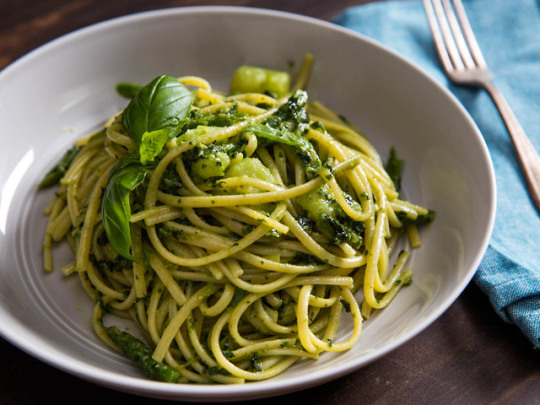
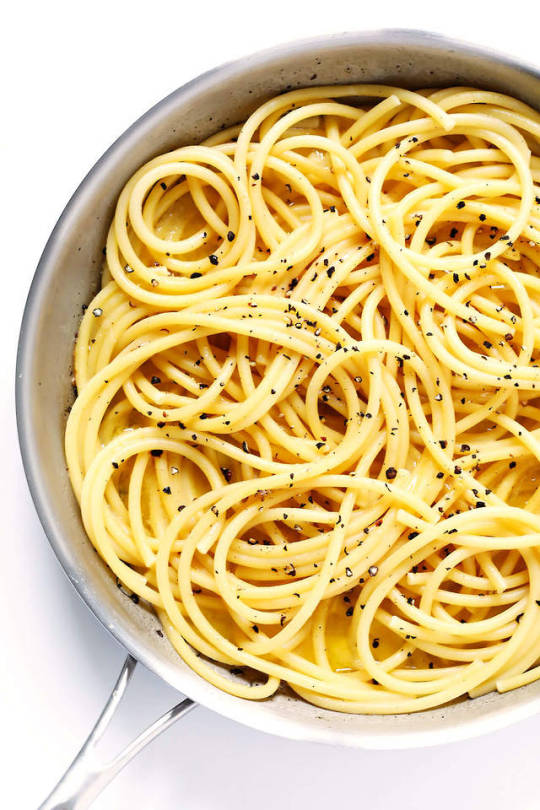
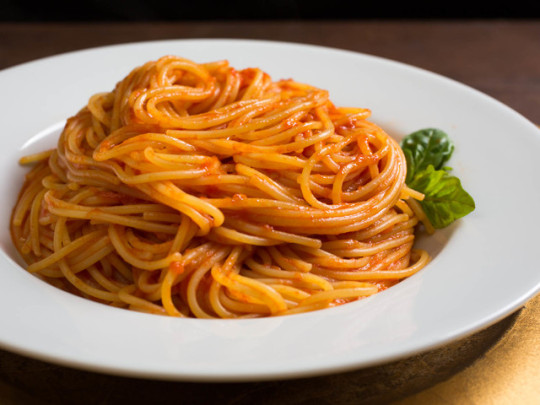
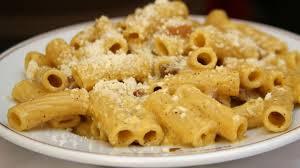




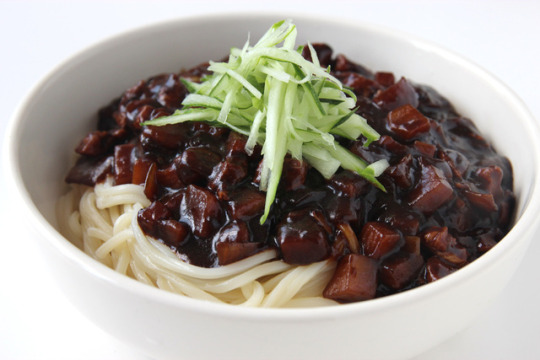
The Twisted History of Pasta
“During the 20th century, Americans developed a love affair with pasta. On the big screen, spaghetti played memorable roles in classic films such as the Marx Brothers’ Night at the Opera (1935), Disney’s Lady and the Tramp (1955), and Goodfellas (1990).”
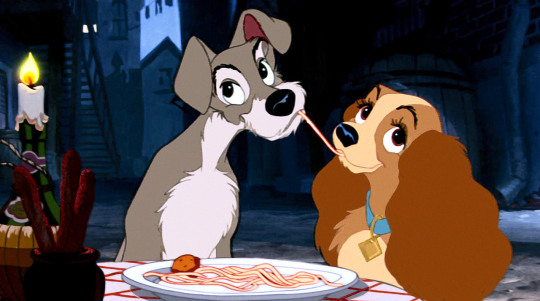
“Pasta’s ethnic roots have been long debated. Many theories have been put forward, some notably far-fetched. An enduring myth, based on the writings of the 13th-century explorer Marco Polo, that pasta was brought to Italy from China, rose from a misinterpretation of a famous passage in Polo’s Travels...Even while Polo was away on his travels in the 1270s, there is a reference to a soldier in the northern Italian city of Genoa, who owned a basket of “macaronis.” A century before, the Muslim geographer al-Idrisi wrote of seeing pasta produced on Sicily.
Many Italian writers have argued that a tomb from the fourth century B.C. bears a relief of pasta-making equipment, suggesting the dish was being enjoyed in pre-Roman Italy...From the 13th century, references to pasta dishes—macaroni, ravioli, gnocchi, vermicelli—crop up with increasing frequency across the Italian Peninsula.”
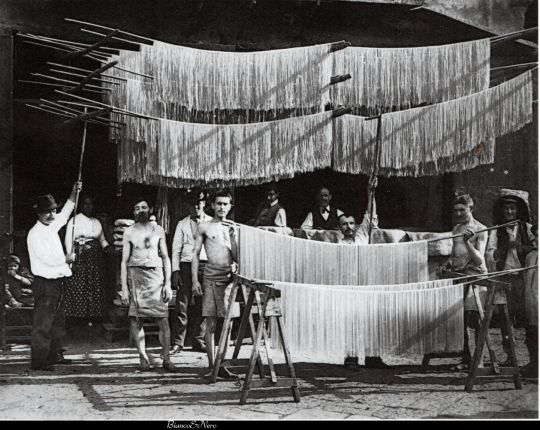
”Pasta was considered a dish for the wealthy, taking pride of place in aristocratic banquets during the Renaissance...in the middle of the 16th century...Pasta, by the late 17th century in Naples, was becoming the main staple of the common diet. Neapolitans had been nicknamed leaf-eaters (mangiafoglia) in the 1500s. From the 1700s they started to be called macaroni-eaters (mangiamaccheroni) instead...the main reason for pasta’s dramatic spread was that, from the 17th century, industrial pasta production was developed with the use of machines such as the torchio, a mechanical press to make noodles or vermicelli.”
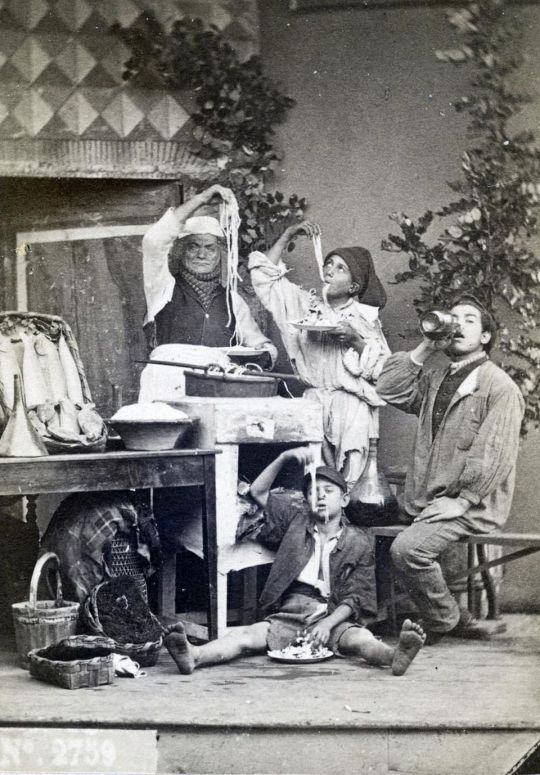
“Several things that have changed drastically over time are the flavorings added to pasta. Sweetness has been replaced by savory, sugar swapped out for vegetables, which helped make pasta a nutritionally complete dish. Then, at the beginning of the 19th century, tomatoes were added. For a long time Italians considered them to be too exotic. In fact, it is not until 1844 that the first recipe appears for the most common pasta dish today: spaghetti in tomato sauce.”
(via The Twisted History of Pasta | National Geographic)

Tracing the Origins of the Noodle
“Noodles are eaten as pho in Vietnam, chow-chow in Nepal, seviyan in India and many other permutations and combinations throughout the globe. While the popularity of noodles is a widely accepted consensus, its origin is still a prominently debated subject. There are numerous contenders who have claimed to be the creators of the Noodle. Italians profess that they are the pioneers of this plant based food, whereas the Chinese argue that they invented this culinary sensation.
Pasta is an integral part of the Italian diet and culture. With shapes ranging from small pinwheels to large sheets, its diversity can be witnessed across the regions of this unified country. Each Italian province has its own rich history with pasta, shaped by its geographical limits and foreign influences, and as a result unique dishes native to these expanses have become a beacon for their identities. The emergence of Pasta in Italy was formerly attributed to Marco Polo, a venetian explorer. He voyaged to China, and upon his return in 1295, he brought back copious amounts of spices and other discoveries which included noodles.”
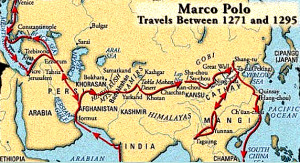
‘Well, Marco Polo might have done amazing things on his journeys, but bringing pasta to Italy was not one of them: noodles were already there in Polo’s time.’(Demeteri, 2018)
[P]asta already existed during the Roman-Etruscan era as ‘Lagane’... Apicius...was a Roman author, who discussed a recipe of ‘laganon’ in his discourse published in the first century AD. These written accounts date back thousands of years. Pasta has thus been a component of the Italian diet for centuries.”
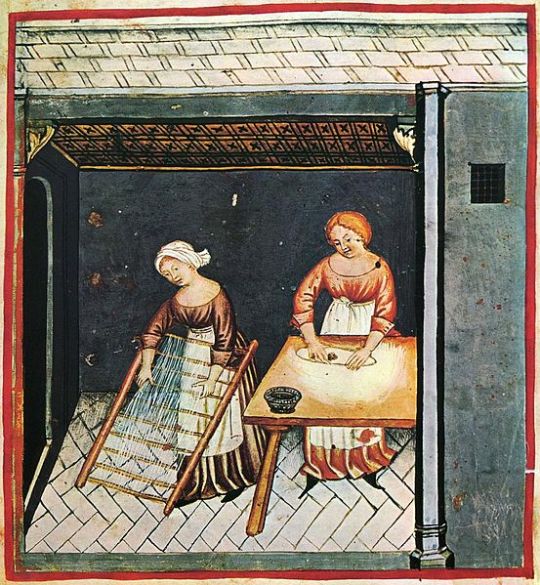
“Arabs played a role in the development and spread of boiled noodles or ‘itriyah’. They significantly influenced Italian food and culinary practices when they invaded the country in the 8thCentury AD. Their cuisine and culture was adopted in regions such as Sicily, where the spread of sweet and savory foods such as pasta con la sarde was observed after the Arabic conquest. Macaroni too, gained widespread admiration amongst the Sicilians at this time.”
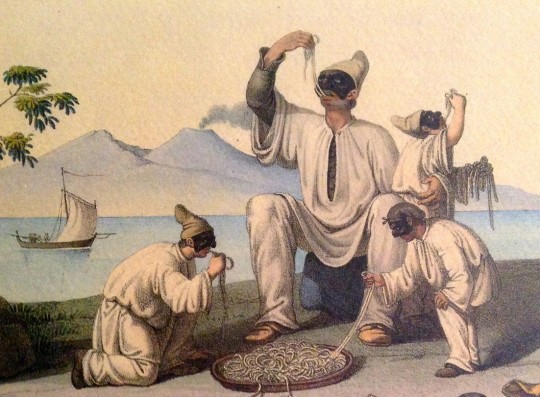
“Ramen is not only a culinary phenomenon here; it is a cultural marvel as well. Japan has museums dedicated to this fast-food, ramen stalls throughout the country, and television cooking shows fashioned around this spicy broth with noodles. The widespread consumption of Ramen by the residents of Japan is unparalleled by any other people. These facts beg the question ‘who are the ancestors of these instant noodles’ ‘was there a Japanese predecessor to this curried noodle dish’. On further research it becomes clear that ramen was introduced to Japan in the form of noodles, from China...Ramen, in present day, has become a national staple food in post-war Japan. Even though noodles weren’t devised here, they have become a vital part of the country’s national identity and the favorite grub of its people.”

“[T]he most plausible birthplace of the noodle is China...However, even though China maybe the site of the first instances of noodles and they may have introduced some countries like Japan and India to them, this doesn’t necessarily mean that they were the ones who introduced the rest of the world to it. Italians were enjoying pasta long before Marco Polo brought back the secrets of the Chinese noodle trade. As there is very little documented data and only a few preserved artifacts related to Italian pasta, it’s not right to make any broad claims about its beginning. It is also plausible that pasta developed spontaneously in China and Italy at different time periods.”
(via Tracing the Origins of the Noodle | Noodles On The Silk Road blog)
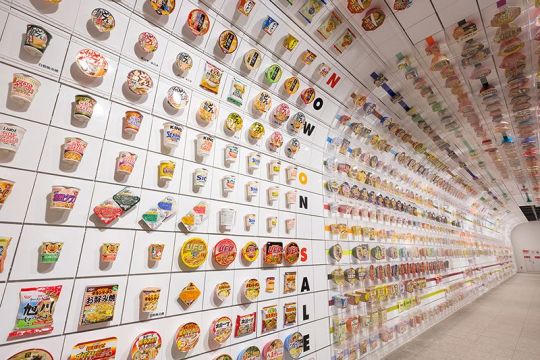
Andō Momofuku: An Inventor Who Used His Noodle to Change Global Food Culture
“ Instant ramen: just add hot water and you have a meal in a few minutes, anytime, anywhere. The product had its beginnings with Chicken Ramen by Nissin Foods, invented by Andō Momofuku in a backyard workshop.
Andō Momofuku (1910–2007) was rightly known as “Mr. Noodles.” His instant noodles, invented in 1958 [48 years old], record yearly sales of 5.5 billion units in Japan alone; worldwide, nearly 100 billion portions are consumed every year, truly making the product a “global food.” Nissin Food Products, the company Andō founded, is part of the Nissin Group, which has grown into a giant with net sales of more than ¥490 billion in the fiscal year ending March 2017.
But before success came many trials. Andō was an up-and-coming industrialist who lost all his wealth overnight. By the time he invented Chicken Ramen, the world’s first instant ramen, he was already 48 years old.”

“Andō left these words: “In life, it’s never too late. It took me forty-eight years to invent this product.”
The idea for instant ramen came to Andō at a black market near Osaka’s main train station during the years of severe food shortages following the war. Under a cold winter sky, he saw a long line of people lined up waiting their turn to eat a bowl of ramen...A few years later, when he did not know where his own next meal was coming from, he recalled that scene and decided to try developing ramen that was simple to make and easy to eat, in addition to keeping well.
[Ando] came up with the flash-frying method, frying the noodles briefly to eliminate moisture. Andō’s hometown of Tainan is known for yi-mian, a type of noodle that is deep-fried before boiling...Andō got the idea from his wife Masako’s tempura. Seeing how she prepared crispy tempura by frying it in a way that drove out excess moisture, he hit on the notion of flash-frying his noodles.”
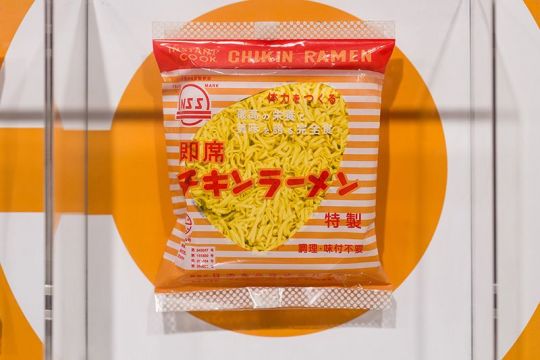
“Thanks to Andō’s experimentation, Chicken Ramen, the world’s first instant ramen, went on sale in August 1958. The noodles are permeated with a concentrated soup consisting of chicken stock and seasonings; simply adding hot water produces a steaming bowl of ramen. Called mahō no rāmen, “magic ramen,” when it first went on the market, Chicken Ramen became a runaway hit.
When Andō first told Masako that he was going into the ramen business, she reportedly said: “If you’re going to do that, make sure you become Japan’s best ramen maker.” Her admonition came true, as Andō watched yearly sales of his Chicken Ramen reach ¥4.3 billion just five years later.”
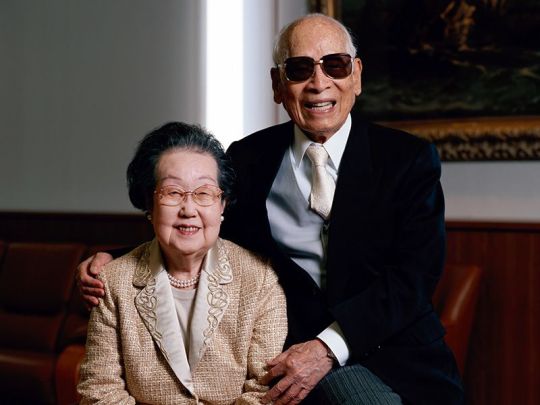
(via Andō Momofuku: An Inventor Who Used His Noodle to Change Global Food Culture | Nippon.com)

Great Tomato Substitutes for Everyday Cooking
Whether you have an allergy, sensitivity, or intolerance to them as I do, or you simply don't have tomatoes on hand, here are some great substitutes for tomato sauce, crushed tomatoes, and more that you can use in your everyday cooking.
In my effort to both eat foods that taste tomato-like and also save my health, I accidentally found the tastiest substitute in a product that is pre-made, called Marco Polo Ajvar,”

”This is actually a red bell pepper and eggplant spread that has an uncanny similarity to the texture and taste of tomato sauce. The ingredients in this Ajvar are: peppers, eggplant, sunflower oil, salt, sugar, distilled vinegar, and garlic. The product is imported from Bulgaria, which is one of the reasons the ingredients are very wholesome...This product is highly suited for people with allergies and intolerances to tomato. I'm a little addicted to this stuff myself. People you serve this sauce to might not even know it isn't tomato sauce. That is how close the flavor is.”

“If you are on the market for a barbecue sauce without tomatoes, try one that is mustard-based...This sauce is from a South Carolina recipe that's been perfected over four generations. Common ingredients in mustard-based sauces include molasses and vinegar and a great blend of herbs and spices. You will not miss the tomatoes at all, and your guests and family will enjoy this as well.”
(via Great Tomato Substitutes for Everyday Cooking | Delishably)

Filipino spaghetti
“Filipino spaghetti, also known as sweet spaghetti, is a Filipino adaptation of the Italian spaghetti with Bolognese sauce. It has a distinctively sweet sauce, usually made from tomato sauce sweetened with brown sugar or banana ketchup. It is typically topped with sliced hotdogs or smokedlongganisa sausages, giniling (ground meat), and grated cheese. It is regarded as a comfort food in Philippine cuisine.
The dish is believed to date back to the period between the 1940s and the 1960s. During the American Commonwealth Period, a shortage of tomato supplies in the Second World War forced the local development of the banana ketchup. Spaghetti with Bolognese sauce was introduced by the Americans and was tweaked to suit the local Filipino predilection for sweet dishes.”
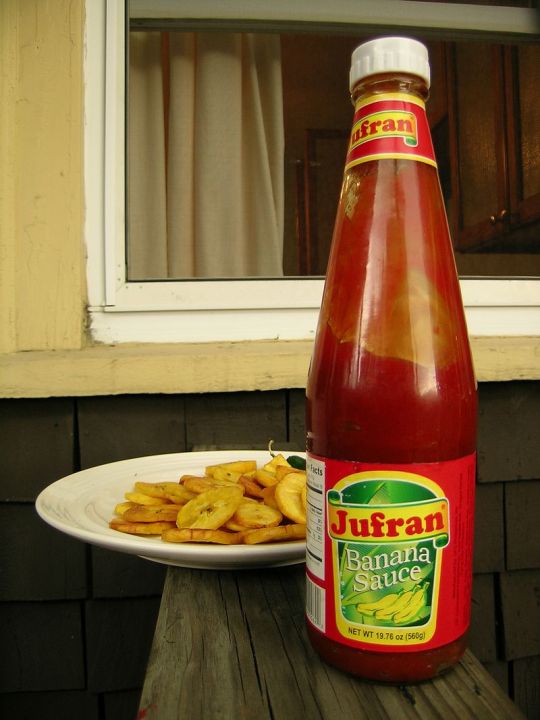
Banana ketchup
Banana ketchup or banana sauce is a popular Philippine fruit ketchup condiment made from mashed banana, sugar, vinegar, and spices. Its natural color is brownish-yellow, but it is often dyed red to resemble tomato ketchup. Banana ketchup was made when there was a shortage of tomato ketchup during World War II, due to lack of tomatoes and a comparatively high production of bananas.”
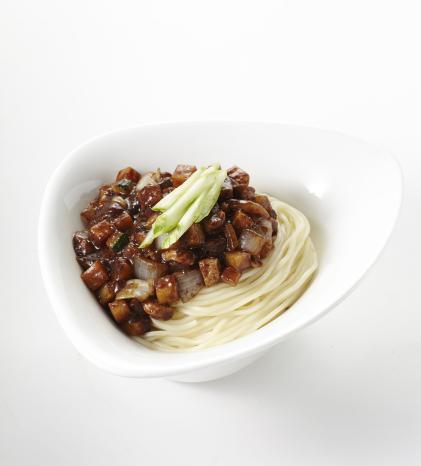
Jajangmyeon
“Jajangmyeon or jjajangmyeon is a Chinese Korean noodle dish topped with a thick sauce made of chunjang, diced pork, and vegetables.
Jajangmyeon dates back to 1905, when it was introduced in Gonghwachun, a Chinese restaurant in Incheon Chinatown run by an immigrant from the Shandong Province of China. The restaurant is now the Jjajangmyeon Museum.
In the mid-50s in South Korea, soon after the Korean War, jajangmyeon was sold at low prices so that anyone could eat it without burden. The new Korean-style Jajangmyeon began to gain explosive popularity among the many merchants visiting the port of Incheon, which was the center of trade, and the many dock workers working in the fish market, and quickly spread throughout the country.“
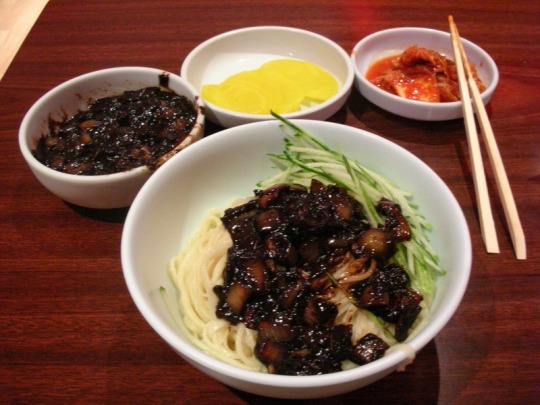
Can My Dog Eat Pasta?
“The answer is maybe. In its plain form, pasta is unlikely to harm your dog, especially in moderation. However, it is worth being careful, as some pets have wheat allergies or are sensitive to grains. Pasta has very minimal nutritional value as well, so while it isn’t poisonous, it shouldn’t be a regular part of your dog’s diet.
Oh, and avoid the sauce. Onions and garlic are toxic to dogs, so pasta sauce can make your dog sick.”

Can my dog eat spaghetti?
Only plain! If the spaghetti is in sauce, most sauces contain onions and garlic, which are toxic to dogs so avoid them completely to be safe. That’s not to mention that most spaghetti sauces include sugar and salt at problematic levels for dogs.
Can my dog eat ramen?
Nothing quite like a salty, meaty, bowl of hot ramen. Unfortunately, both traditional ramen and instant ramen are too salty for your dog to enjoy. If you’re feeding your dog plain ramen noodles, those are usually fine, but again, offer no nutritional value...It’s also good to note that onion and garlic are both popular ingredients in instant ramen flavor packets, so sharing noodles from your bowl isn’t a great idea for your dog.”
(via Can My Dog Eat Pasta? | Rover.com)

#pasta#spaghetti#macaroni#laganon#noodles#marcopolo#pho#chowchow#chowmein#ramen#andomomofuku#nissinfoods#filipinospaghetti#bananaketchup#blackbeansauce#jajangmein#firstdatedinner#tomatofree#mealideas#dogscaneatplainpasta
0 notes
Text
Tefaf Shakes Things Up With Cross-Collecting
When the European Fine Art Fair arrived in New York and set up in Park Avenue Armory four years ago, it was enough to be exactly what it was: a fair that boasted European old master paintings and antiquities and catered to museum curators and high-end connoisseurs.
Several years in, Tefaf is examining its clientele and tweaking its game plan. Among many of its 90 vendors, “cross-collecting,” or assembling private collections of art from different eras and categories, is a trend now, and Tefaf has responded by including 7 collaborative booths on its upper floor. Here, modern or contemporary art is displayed alongside ancient artifacts or Renaissance works in jarring, imaginative and sometimes radical ways. (It’s long been a signature of Axel Vervoordt, the antiquarian, designer, and founder of his Belgium-based company.)
France grabbed the world’s attention when Notre-Dame cathedral caught fire in April. Cultural programming feels particularly French-focused this year, with a report on Sunday for plans on rebuilding Notre-Dame; a panel on early 20th-century French fashion; and the American premiere of “Decoding Da Vinci,” a film co-produced by the Louvre Museum commemorating the death of Leonardo 500 years ago — while in the employ of the French court of King Francis I.
For aficionados and collectors of Chinese and Latin American art, these works are the subjects of panels (though not much represented in the fair itself). The educational offerings, titled Tefaf Afternoons and Tefaf Coffee Talks, sound casual, but they are helmed by experts, the same way every object in the fair is vetted by specialists, including other dealers. At $55 per single-entry ticket ($25 for students), Tefaf is an investment, both in time and money, but the assumption is that you can afford it.
The collage aesthetic — juxtapositions of diverse and seemingly unrelated elements — has reached the art fair format. If you don’t mind the mixing of media, millenniums and cultural mind-sets, this is a good thing. A standout pairing is the contemporary art dealer Sean Kelly and the antiquities dealer Charles Ede (Booth 210). Among their smart displays are a photograph of the artist Marina Abramović, her face covered in honey and gold leaf to recreate a Joseph Beuys performance from the 1960s, next to a 2nd or 1st century B.C.E. Hellenistic head of a man, carved with parted lips and a bulging brow that suggests he was a powerful orator. Next door, Benappi, Mehringer, and Cortesi (Booth 211) are showing mid-20th-century European modern painting with Spanish renaissance sculpture. The Peruvian-born, Milan-based artist Jorge Eielson (1924-2006), who stretched and tied portions of his canvases into knots, can be found behind a 16th-century walnut sculpture of the hermit Saint Jerome by Juan de Valmaseda, suggesting wildly different approaches to dynamism in art.
Decorative Arts
Originally, Tefaf New York showed contemporary art in the spring and decorative arts in the fall. Contemporary art has clearly infiltrated this edition of Tefaf — a sign of its viral popularity — but furniture, silver and other decorative objects are well represented. A pair of 17th-century Japanese screens at Gregg Baker (Booth 353) feature a fall scene and a cherry tree made of blossoms created from crushed abalone shells. Burzio (Booth 336) has a hulking Italian table made around 1600 for the Alessandri family’s palace in Florence. Lavishly inlaid with coral, lapis lazuli and marble, and with gilt wooden legs, the table is a none-too-subtle display of the family’s wealth and power.
A wrought iron fireplace hood designed in the 1880s by Louis Comfort Tiffany for his East 72nd Street home, and then his Long Island estate — accented with distinct Japanese motifs — is at Lillian Nassau (320), while the French dealer J. Kugel (Booth 301) has a deliciously funky, mid-17th-century vessel by Hans Clauss of Nuremberg from a nautilus shell and gilt silver and featuring the Roman god of the sea, Neptune, grasping a seashell in his hand. Holding down the modern end, Anne-Sophie Duval (Booth 203) has a 1930 cream-colored leather armchair with ebony legs designed by Jean-Michel Frank, who combined raw materials with cool, classical lines to create a new minimal aesthetic.
Visionaries
In an age when fantasy and post-truth serve as refuges from nastier realities, there has been a perceivable spike in visionary art. Tefaf is liberally sprinkled with masterful proponents of this trend, throughout history. A fantastic allegory of “Ignorance, Envy and Jealousy” (1837) by the British Royal Academy painter James Ward is at French & Company (Booth 312). Complete with snakes, monsters, a shimmering rainbow and Truth (a statuesque woman) dressed in white, the canvas, which once belonged to the Royal Shakespeare Company, might have been considered academic kitsch a few decades ago. In our era, however it looks like a deliciously hallucinogenic mash-up of William Blake and internet emojis. Dreams and hallucinations were also near and dear to Surrealism, and Max Ernst provided some of its strongest images. A 1939 painting by Ernst of poplar trees at Galerie Thomas (Booth 308) makes foliage look like fossilized megaliths.
Notable Women
The hallway at the Armory is lined with color photographs by the Amsterdam-based photographer Carla van de Puttelaar of important women in the art world, including collectors, curators and other luminaries. A couple of female artists — not unknown, but certainly underrecognized — to look out for include the sculptor Germaine Richier at Galerie de la Béraudière (Booth 104) and Agnes Pelton at Bernard Goldberg (Booth 102). Richier’s sculptures somewhat resemble those of Alberto Giacometti. Like him, she was a student of Antoine Bourdelle (who was, in turn, a student of Auguste Rodin). Richier’s 1956 sculpture of a couple at Béraudière shows her technique of displaying brass with no patina, so it looks almost like gold.
In Pelton’s diminutive canvas “French Music” from around 1917 at Goldberg, sprites and spirits swirl through the lower regions. Pelton could be filed under visionaries: Her work tried to fuse color, sound and vision with occult shadings. The little work here serves as an appetizer to a retrospective of Pelton at the Whitney Museum that will be held in the spring, when Tefaf arrives again.
TEFAF NEW YORK FALL
Nov. 1-5; Park Avenue Armory, Manhattan; tefaf.com.
Sahred From Source link Arts
from WordPress http://bit.ly/2PxbpJ7 via IFTTT
0 notes
Text
Task 1 - Specialist Field
What is your specialist field? My specialist field is graphic design and traditional artwork.
Are there common materials and techniques involved in the practice of this specialism? Within graphic design, common materials involve a computer, digital photo software (such as Photoshop, GIMP, or CorelDraw), digital screentones, textures, and fonts, a graphics tablet and pen, PANTONE colour guides, a sketchbook, and an iPad or digital tablet. Common techniques in graphic design include gradients, colour theory and harmony, typography, digital image manipulation, halftone printing, hierarchy, contrast, negative space, and double exposure.
Within traditional artwork, common materials involve pencils, graphite, and charcoal, coloured & watercolour pencils, blue sketching pencils, dry & oil pastels, ink, oil paints, watercolour paints, acrylic paints, gouache paints, markers, rubbing alcohol, paintbrushes, rulers, rubbers, and a sketchbook of good quality. Common techniques in traditional artwork involve drawing, painting, sculpture, printmaking, glass painting, fresco, action painting, shading, crosshatching, contouring, light sources, use of screentones, perspective, and monochromatic colour.
The two can often cross over in terms of techniques and materials - for example, a lot of digital painting software offers traditional art techniques and digital brushes, while light sources and monochromatic colour are just as important for graphic design.
How long has this specialism been practiced? Does it have a history and can we trace the development of this specialism through the research of key individuals? Traditional art has been practiced since humans learned how to express themselves artistically, beginning with cave paintings in 30,000 B.C. to 2500 B.C. During the Egyptian period, art was created using clays, minerals, and charcoal as paint and papyrus and reeds for brushes - the Egyptians pioneered hieroglyphics as text, a very early form of a picture book. Chinese and Japanese art during the 1800s focused on recreating themes from classical literature, nature, and spiritualism, as well as pioneering woodblock printing. The Great Wave off Kanagawa by Katsushika Hokusai is probably the most well-known Japanese traditional painting from the 1800s. The Middle Ages saw the beginning of Celtic, Gothic, and Romanesque art, influencing much modern art. The Renaissance era gave us some of the most well-known names in classical art - Michelangelo, Donatello, and Botticelli - and some of the most well-known art pieces of all time. Renaissance art has influenced everything from fashion to music. Later into modern history, art styles such as cubism, constructivism, dadaism, and abstract expressionism began to form from the beginning of the 1900s onwards. The late 1900s saw pop art and postmodernism begin to take hold.
Graphic design initially began in the Renaissance and industrial era. With the invention of the printing press, humanity could recreate text on a mass scale, and with that came the desire for fonts. Modern companies took notes on how aesthetics could influence consumer habits. The printing industry began using logos in the 1400s. This was important as how well your logo was printed reflected on how well everything was printed. The first print advertisements began to appear in the mid-1600s. One of the earliest known advertisements is for a horse and cart renting service. The mid-1800s bought chromolithography into printing, due to the advancement of technology. This allowed prints to be detailed, sharp, and in colour. It also enabled realism in images. The first graphic design agency - Austria’s Wiener Werkstätte - appeared in 1903. It was an organization of painters, artists, and early graphic designers, and provided a roadmap for other collaborative agencies to follow. Bauhaus, possibly the most famous name in graphic design, opened its doors in Germany in 1919. It provided a schooling to future influencers of graphic design and modern art movements. From the 1950s onwards, the digital era slowly rose to prominence. Adobe Photoshop was first launched in 1990, and changed the face of graphic design forever. Networks such as MTV bought a new take on logos with every ad bumper, constantly changing their design while still maintaining recognisable characteristics.
How is your specialism practiced today? Traditional art is still practiced worldwide, most commonly in sketching. Comic books are the biggest commercial form of traditional art, as well as manga and anime. Painting eras such as Baroque and Romanticism have came back in popularity, with painters such as Roberto Ferri drawing on them highly as sources of inspiration. Drawing challenges such as ‘Inktober’ provide an opportunity for artists to stretch their traditional muscles, with the artist having to draw a traditional sketch every day throughout the month of October. Street art has also became popular as an art form, with graffiti artists like Banksy fetching high prices for their pieces.
Digital art is incredibly common amongst young people, most likely due to the mass and easy access of design apps and software. Vaporwave, surrealism, pop art, glitch art, minimalism, collages, photo comics (such as A Softer World), and typography are all modern forms of digital art. Websites and companies such as VICE and Thrasher all promote a minimal, clean aesthetic with focus on sans-serif text, monochromatic colours, and inspiration from street art.
Research a number of specialists in this field today/people who influence you
Name: Aubrey Beardsley Born: 21 August 1872 – 16 March 1898 Nationality: English Profession: Illustrator, author Biography: Born in Brighton, England, Beardsley’s first cartoons and illustrations appeared in his grammar school’s magazine. He attended Westminster School of Art in 1892, before travelling to Paris where he discovered the poster art of Henri de Toulouse-Lautrec, and the Parisian fashion for Japanese prints. Both became major influences on his style. Beardsley became controversial in the art world for his images detailing erotica and dark aesthetics. He died of tuberculosis in 1898. Art style: Art Nouveau, aestheticism. His illustrations were mostly in stark black and white, created through the use of ink and paintbrushes. Notable pieces: The Peacock Skirt (1893), The Black Skirt (1894-5), The Dancers Reward (1891), The Barge (1896), Isolde (1899)
Name: Roberto Ferri Born: 1978 Nationality: Italian Profession: Artist, painter Biography: Ferri was born in Taranto, Italy. In 1996, he graduated from the Liceo Artistico Lisippo Taranto, a local art school in his hometown. He moved to Rome in 1999, and began to study painting on his own. He displayed a strong interest in painting beginning at the end of the 16th century, in particular. he graduated with honours from the Academy of Fine Arts in Rome in 2006. Art style: Romanticism, Symbolism, Baroque art Notable pieces: Fallen Angel (2011), Il Canto Della Vergine (2015), Lucifer (2013), Redemption (2011), The Marriage of Heaven and Hellway (2011), Achille (2017)
Name: Andy Warhol Born: August 6, 1928 – February 22, 1987 Nationality: American Profession: Artist, photographer, printmaker, director Biography: Warhol was born in Pennsylvania. In the third grade, he developed a complication of scarlet fever, and while confined to bed, drew, listened to the radio, and collected images of movie stars. He won a Scholastic Art and Writing Award as a teen, and studied commercial art at the Carnegie Institute of Technology. After earning a Bachelor of Fine Arts in pictorial design in 1949, he moved to New York City and began a career in magazine illustration and advertising. He was an early adopter of the silk screen printing process and used this to develop his ‘blotted line’ technique, applying ink to paper and blotting the ink while it was still wet. During the 1960s, he began to make paintings of iconic American objects such as dollar bills, Campbell's Soup Cans, Coca-Cola bottles, as well as celebrities such as Marilyn Monroe, Marlon Brando, Muhammad Ali, and Elizabeth Taylor. He also made sculptures, movies, and took photographs of personalities such as Edie Sedgwick. He founded “The Factory’, his studio space, and gathered a squad of creatives, bohemian personalities, and underground celebrities. A controversial and renowned artist, he died in 1987 in his sleep due to an irregular heartbeat. Art style: Pop art, sculpture, film, photography Notable pieces: Marilyn Diptych (1962), Campbell’s Soup Cans (1962), Green Coca-Cola Bottles (1962), Race Riot (1964), Big Electric Chair (1967)
Name: Jim Fitzpatrick Born: N/A Nationality: Irish Profession: Artist Biography: Educated at the Franciscan College in Gormanston, County Meath, Jim Fitzpatrick became known for his intricate and detailed artwork inspired by the Irish Celtic tradition. He has produced much artwork for Irish rock band Thin Lizzy, as well as The Darkness and Sinéad O’Connor. However, his most well-known image is ironically the 1968 two-tone portrait of Che Guevara. Art style: Irish Celtic art Notable pieces: Che Guevara (1968), Aille the Fair (1975), Chinatown (1980), Black Rose (1979)
Name: Ellen Bernard Thompson Pyle Born: November 11, 1876 – August 1, 1936 Nationality: American Profession: Illustrator Biography: Born in Philadelphia, Pyle began her studies at the Drexel Institute of Art, Science and Industry in 1895. She studied under Howard Pyle in 1897, becoming one of his top students, and was given commissions for periodicals and books. During the 1920s, she began work at the Saturday Evening Post and created 40 covers for the paper under the guidance of the editor-in-chief, George Horace Lorimer. She died in 1936 of heart disease. Art style: Contemporary art Notable pieces: Flapper (1922), Woman with Headband (1922), You’ve Come a Long Way Baby (1926), Ermine Muff (1923), Pretty in Pink (1930)
What kind of work flow is followed within your specialism? In both traditional and graphic art, the work flow and ideas generation process is very simple. First off, the artist will think of an idea and then note it down - this can be in a sketchbook, a notepad, or on Post-It notes. After that comes doodles or a moodboard of what the artist wants to portray - this can be composed of anything, such as photography, existing designs or art, people, fashion, makeup, or even music. It all comes down to whatever strikes the creativity of the artist. After the moodboard is created, the artist will create concept sketches or different ‘rough’ versions of their idea. They will then use these sketches to formulate their final idea. This video shows a typical art workflow for a company logo, as given by Aaron Draplin:
youtube
0 notes
Photo

The Four Accomplishments, Kano Shoei, late 1500s, Cleveland Museum of Art: Japanese Art
At first this scene appears a bit strange, if not bizarre: men, young and old, sit in a vast wilderness playing a board game or executing an ink painting. The furniture and ceramic wares are elegant, the attire is fashionably informal, and the young attendants outnumber the gentlemen of leisure. Clouds and mist roll through the landscape, whose bleakness suggests late fall or early spring, a chilly time to be outdoors engaged in what Westerners would call pastimes or hobbies. But we are viewing the past, a pictorial vision of a cultured gentleman’s ideal in classical East Asian history: the Four Accomplishments. This enduring Confucian theme embraces the arts of calligraphy, painting, music, and go (a game of strategy akin to chess), each of which is portrayed or suggested in this pair of 16th-century folding screens, or byøbu. In the left screen, the multiple brushes and a large flat rock surface for writing refer to painting and calligraphy; in the right screen, a seven-stringed musical instrument called a qin, protected in cloth and resting on the large wooden table close to the game players, indicates music and the game of go. The daily pursuit of one or more of these activities has a venerated history in ancient China, one that was transmitted to Korea and Japan by at least the 1400s, when interest in Chinese culture pervaded medieval Japanese society. In Kyoto, Zen culture favored this theme, introducing it into mural painting programs organized for temple interiors as early as the late 1400s. The Kano school painters, in particular, are noted as the most prolific exponents of this theme, and their popularity reached a high point in the early 1600s. The Kano atelier produced many hundreds of paintings in various formats for private and institutional clients, guided by the work ethic, management skills, and academic painting style of Kano Motonobu (1476–1559). These byøbu follow that master’s style as exemplified in the sliding-door panel paintings depicting Zen patriarchs from the Daisen-in subtemple at the Daitoku-ji in Kyoto (c. 1513). Traditionally attributed to his son Kano Shøei, those byøbu show Motonobu’s legacy of distinctive “nailhead” brushstrokes (in the depiction of robing), spiky and elongated plant forms, and crystalline rock formations. The new, more relaxed pictorial elements and broader painting techniques that give this composition a distinct sense of quietude, however, suggest the hand of Kano Yukinobu, who was also active in the later 1500s in Kyoto. Comparison with the narrative and compositional elements of Horses and Grooms in the Stable (1934.373) is as enlightening as it is instructive in helping distinguish yamato-e and kara-e painting styles, parallel streams in medieval Japan. Two unobtrusive elements in the byøbu here provide insights into the evolution of the Four Accomplishments theme in the 1500s. First is the greater importance placed on the depiction of a landscape setting. Second, these lofty exemplars of classical China are portrayed in groupings that convey a distinctive relaxed ambience when compared to earlier Chinese or Japanese presentations. To understand this important leitmotif emerging in conventional ink painting circles at mid-century, one need only gaze at the young page slouched beside the stream watching fish swimming nearby. Confucian ideals as well as notions of Zen rectitude have been superseded in these byøbu by a series of beguiling vignettes showing human engagement and companionship in an open and receptive natural setting. Size: Overall: 174 x 378.5 cm (68 1/2 x 149 in.) Medium: pair of six-fold screens, ink and light color on paper
https://clevelandart.org/art/1979.46
42 notes
·
View notes
Text
K-pop and fancy sneakers: Kim Jong Un’s cultural revolution
PYONGYANG, Korea, Democratic People’s Republic Of — Dancers in hot pants. Factories pumping out Air Jordan lookalikes. TV dramas that are actually fun to watch.
North Korean pop culture, long dismissed by critics as a kitschy throwback to the dark days of Stalinism, is getting a major upgrade under leader Kim Jong Un.
The changes are being seen in everything from television dramas and animation programs to the variety and packaging of consumer goods, which have improved significantly under Kim. Whether it’s a defensive attempt to keep up with South Korea or an indication that Kim is willing to embrace aspects of Western consumer culture that his predecessors might have viewed as suspiciously bourgeois isn’t clear.
“The most important thing for us is to produce a product that suits the people’s tastes,” Kim Kyong Hui of the Ryuwon Shoe Factory told The Associated Press recently in the facility’s showroom, which is filled with dozens of kinds of shoes for running, volleyball, soccer — even table tennis. “The respected leader Kim Jong Un has instructed us to closely study shoes from all over the world and learn from their example,” she added, pointing to a pair of flame-red high-top basketball shoes.
To be sure, North Korea remains one of the most insular countries in the world. Change comes cautiously and anyone who openly criticizes the government or leadership or is seen as a threat can expect severe repercussions. But there appears to be more of a willingness under Kim to experiment around some of the edges.
The most visible upgrades are on television and its normal menu of propaganda programs and documentaries in praise of the leaders.
Viewers of the main state-run TV network — the only channel that can be seen anywhere in the country — are now stopping their routines to watch the latest episodes of “The Wild Ginseng Gatherers of the Imjin War,” a historical drama set in the late 16th century, when Korea was struggling against a Japanese invasion.
The anti-Japan, nationalistic theme is nothing new. A similar theme was used for Kim Jong Un’s first big contribution to the television lineup, an animated series reviving a popular comic from his father’s era called “The Boy General” that made its debut in 2015. The animation, set in the Koguryo period when Korea was fighting off Chinese incursions, was such a hit that people would stop whatever they were doing to watch it. A Boy General game was created for mobile phones. New episodes are believed to be forthcoming.
What the TV drama, first aired last July, and the Boy General animation share that’s new is their high production values.
The acting in the movie is grittier and more compelling, the plots more engaging and the sets and costumes are decidedly more elaborate than previous projects. Even the dialogue spoken in Japanese by the villains, played of course by North Korean actors, is generally accurate, though delivered with a heavy North Korean accent. The Boy General, meanwhile, makes skilful use of computer effects and is visually on par with some of the best animation in the world.
The improvements reflect awareness within Kim’s regime that the North Korean public is increasingly familiar with foreign pop culture despite severe restrictions that make it impossible for most to travel abroad or freely experience foreign movies, music or books.
That familiarity is particularly true of the North Korean elite, who are accustomed to seeing brand name products from Dior to Sony on the shelves of upscale stores in Pyongyang, the capital. Cheap knockoffs from China are common in marketplaces around the country.
Watching South Korean movies or listening to South Korean music is illegal. But a lot makes its way over the border and, even for those who would never dream of taking that risk, the officially approved cultural fare isn’t entirely void of foreign treats.
Bollywood films are popular in state-run cinemas — 2009’s “Three Idiots” with Aamir Khan, for example, was recently shown in a cinema just across the street from Kim Il Sung Square. North Korea’s educational channel regularly features long clips from foreign documentaries, and dog-eared Harry Potter books are among the most popular items at the People’s Grand Study House, North Korea’s biggest library.
North Korea’s “approach to the influx of foreign media has been to ‘modernize’ media production to provide an attractive and competitive product that caters to younger generations for whom older productions are no longer attractive,” said Geoffrey See, the founder of the Choson Exchange, a Singapore-based non-profit that supports change in North Korea through exposure to knowledge and information in business, entrepreneurship and law.
“For consumer goods, it also ties into a state policy to encourage more domestic production and import substitution,” he said.
Kim’s first attempt to update the pop culture scene started almost as soon as he assumed power in late 2011 with the creation of the Moranbong Band, an ensemble of female vocalists and musicians who are the “soft face” of his regime.
Although the members all belong to the Korean People’s Army, they are known for performing in miniskirts and wearing their hair fashionably short. They have released dozens of songs, all of which get lots of exposure through concert tours, DVDs and airtime on television.
They are beginning to look a bit passe, however.
In February last year, North Korea sent some of its top musicians, including a female quintet that performed in black shorts and red tops, south of the Demilitarized Zone to perform during South Korea’s Pyeongchang Winter Olympics. Two months later, Kim was in the audience as the South Korean girl group Red Velvet put on what is believed to be the first real K-pop show ever held in Pyongyang. The North Korean act that performed in South Korea was so well received that Kim sent them to Beijing last month for another goodwill tour.
Still, military orchestras and classically trained vocalists who perform in traditional “Choson-ot” gowns remain the mainstay of the Pyongyang musical scene. The girl band’s performance in Beijing was backed up by the state’s military chorus and orchestra, all in full uniform.
More importantly, there has been no effort to delink the arts from politics.
When the musical group returned to Pyongyang, Kim urged them to continue to “conduct original artistic activities pulsating with the party’s ideology” and act “courageously as mouthpieces of the party,” according to state media.
——
Talmadge has been the AP’s Pyongyang bureau chief since 2013. Follow him on Twitter and Instagram: @EricTalmadge
from Financial Post http://bit.ly/2tlNlMS via IFTTT Blogger Mortgage Tumblr Mortgage Evernote Mortgage Wordpress Mortgage href="https://www.diigo.com/user/gelsi11">Diigo Mortgage
0 notes
Text
10 Legendary Swords from the Ancient World
Not only are swords weapons, but they also very symbolic, and deeply ingrained in the human psyche. Over the centuries they have been used as symbols of power, used in countless types of ceremonies, as offerings, for coronations, as well as being used for trade. Over time, a number of swords have garnered their own legends and myths, linking the swords to famous events and people. Sometimes the swords themselves are the topic of legendary tales. In this article we’ll look at ten incredible swords from mankind’s history.
Joyeuse: The Legendary Sword of Charlemagne
The sword of Joyeuse, which is now housed in Frances Louvre Museum, is quite possibly one of the most iconic and famous swords in all of history. There are multiple historical records linking the sword to Charlemagne the Great, who reigned over 1200 years ago. The sword itself has been used in uncountable coronation ceremonies over the centuries, and is said have magical powers as well as having a rich legend and history.
The Seven-Branched Sword: Japanese Ceremonial Sword
Nestled in the foothills of Tenri in Nara prefecture, Japan, is the Isonokami Shrine. The shrine which is thought to have been built in 4 AD is home to several Japanese national treasures, including the famous sword Nanatsusaya no Tachi, or ‘Seven-Branched Sword’. If you’re able to read the inscription on the blade, you’ll learn that the Seven-Branched Sword was gifted to the King of Wa, or ruler of Japan, by king of Baekje, which is believed to be an ancient kingdom in the south of Korea. The swords design indicates that it was never meant to be used as a weapon, but rather it was intended to be used as a ceremonial piece.
The Sword in the Stone of San Galgano
If you ever find yourself in Tuscany, Italy, take the time to travel to the top of Montesiepi, where you’ll find a rather pleasant round chapel. Located in the chapel, inside a glass case you’ll see a 12th century sword lodged within a piece of solid rock. According to legend, the sword was thrust into the stone by San Galgano, a knight and local nobleman. The legend says San Galgano was out for a walk when he had a vision of Jesus, Mary and Twelve Apostles. A voice instructed San Galgano to renounce all his worldly possessions. San Galgano replied to the voice saying that giving everything up would be as easy as splitting a stone with his sword, to emphasis the point he drew his sword and thrust it into the stone. To his understandable amazement, the sword went through the stone like a hot wire through margarine, and has been stuck there ever since, allegedly.
Goujian: The Time Defying Chinese Sword
Over fifty years ago, a team of archaeologists uncovered a unusual and rare sword in a Chinese tomb. Despite the sword being over 2,000 years old, the sword seemed to have completely escaped the elements and was rust free. Additionally, the sword was able to draw blood when one of the archaeologists decided to test its sharpness on his finger, despite being a bit stupid, it seemed to prove the sword had managed to survive the ravages of time unaffected. Furthermore, the craftsmanship was incredibly detailed for a sword of this time, and was something of an oddity for the period. The sword is considered a national treasure, and was probably once owned by the Emperor Goujian of Yue.
The Cursed Muramasa Samurai Swords
During the Muromachi period in Japan (14th – 16th Century), there lived a swordsmith named Muramasa Sengo. By all accounts he was exceptionally skilled, but also slightly unhinged, and prone to bouts of violence. The legend states that his destructive nature was passed into the swords he forged. The resulting blades would then be capable of possessing their new owners, which in turn would cause the wielder to become rage filled, unhinged warriors, just like the swordsmith who forged them. Regardless of the dodgy reputation of the swords forged by Muramasa, they were undeniably created by a skilled swordsmith, and therefor proved to be popular in Japan. That was until Edo period, when the first Shoguns father and grandfather where both murdered by their retainers, who fate would have it, both wielded Muramasa blades. So it came to be that the Muramasa blades where thought to hold a curse against the Tokugawa family, resulting in the blades being banned by the Shogun. Just a small number of the blades survived until modern times and they are now considered priceless treasures.
Ulfberht Viking Swords
During the last century, just over 170 Viking Ulfberht swords have been uncovered in and around Europe, dating from approximately 800 – 1000 AD. The sword were incredibly well crafted, and made of metals so pure, that many experts have stated that they were centuries ahead of their time. The Ulfberht swords where made with crucible steel, which contains carbon which was three times higher than any other steel at the time. It was believed that the technology and methods to create this sort of steel was not invented until the Industrial Revolution. It was originally believed that the swords may have originated from Asia or the Middle East, but modern research has identified that the materials used came from central Europe. It is entirely possible, that the methods and knowledge required to forge these swords came from outwith Europe. Interestingly, the Volga trade routes linking the Vikings and the Middle East opened at the same time the first Ulfberht swords appeared, the last of which was produced around the time the trade routes closed.
Ivan the Terrible’s Sword
In 1975, archaeologists in Siberia unearthed a inexplicable medieval sword which appears to have been forged in Germany and decorated in Sweden. The archaeologists where perplexed as to how a 12th century sword created in Europe came to be unearthed from the banks of the River Om in starkly remote Novosibirsk region. Lengthy research and investigations has led to the theory that sword may have once belonged to Tsar Ivan the Terrible, which was given to him as a gift, which was then used in battle ahead of the conquest of Siberia.
Chinese Votive Sword in North America
In the summer of 2014, an unusual discovery was made on the shore of a small stream in Georgia, USA. An intricately detailed Chinese votive sword which was fashioned in Lizardite. The sword was carved with several symbols, including the face mask of the Taotie and a Dragon, which are more commonly found on jade objects from the Xia and Zhou Dynasty periods (1600 – 256 BC). This sword gives weight to the theory that Chinese discovered and travelled to North America thousands of years before Christopher Columbus.
Masterfully Forged Indian Sword
The master swordsmiths behind some of India’s incredible swords was not fully appreciated until scientists from Italy and the UK came together to study the Shamsheer swords. The original design for these swords originated from Persia, where it spread across Asia and eventually evolved into the family of swords now known as Scimitars. The scientists where able to highlight that the steel used in these swords was impressible pure. The carbon content of the swords was around one percent, making the swords stronger and able to keep an edge longer. This type of steel is commonly used in high end swords or other prestige items.
Durandal: Sword of Roland
Embedded in the face of a rock in Rocamadour, which is a site roughly 160km North of Toulouse, is an iron sword surrounded in legend and myth. According to local tales, the sword, named Durandal, had been gifted to Roland, who was a famous figure, popular in medieval tales. Roland was considered to be a formidable warrior, being called the best warrior of the emperors court. One of the stories surrounding Roland is the tale of his last stand battle, the Battle of Roncevaux, which was an actual historical battle, but was later embellished to improve the story. The legend states that Rolands sword was said have fantastical powers, so much so that during the last stand battle, Roland tried to destroy the blade before it fall into the hands of enemy. It is alleged that Roland flung Durandal high in the air, where as it descended it wedged itself in the rock in Rocamadour, where to this day it remains.
from Swords and Knives - Blog https://www.bladespro.co.uk/blogs/news/10-legendary-swords-from-the-ancient-world from BladesPro https://bladesproco.tumblr.com/post/161941984427
0 notes
Text
10 Legendary Swords from the Ancient World
Not only are swords weapons, but they also very symbolic, and deeply ingrained in the human psyche. Over the centuries they have been used as symbols of power, used in countless types of ceremonies, as offerings, for coronations, as well as being used for trade. Over time, a number of swords have garnered their own legends and myths, linking the swords to famous events and people. Sometimes the swords themselves are the topic of legendary tales. In this article we’ll look at ten incredible swords from mankind’s history.
Joyeuse: The Legendary Sword of Charlemagne
The sword of Joyeuse, which is now housed in Frances Louvre Museum, is quite possibly one of the most iconic and famous swords in all of history. There are multiple historical records linking the sword to Charlemagne the Great, who reigned over 1200 years ago. The sword itself has been used in uncountable coronation ceremonies over the centuries, and is said have magical powers as well as having a rich legend and history.
The Seven-Branched Sword: Japanese Ceremonial Sword
Nestled in the foothills of Tenri in Nara prefecture, Japan, is the Isonokami Shrine. The shrine which is thought to have been built in 4 AD is home to several Japanese national treasures, including the famous sword Nanatsusaya no Tachi, or ‘Seven-Branched Sword’. If you’re able to read the inscription on the blade, you’ll learn that the Seven-Branched Sword was gifted to the King of Wa, or ruler of Japan, by king of Baekje, which is believed to be an ancient kingdom in the south of Korea. The swords design indicates that it was never meant to be used as a weapon, but rather it was intended to be used as a ceremonial piece.
The Sword in the Stone of San Galgano
If you ever find yourself in Tuscany, Italy, take the time to travel to the top of Montesiepi, where you’ll find a rather pleasant round chapel. Located in the chapel, inside a glass case you’ll see a 12th century sword lodged within a piece of solid rock. According to legend, the sword was thrust into the stone by San Galgano, a knight and local nobleman. The legend says San Galgano was out for a walk when he had a vision of Jesus, Mary and Twelve Apostles. A voice instructed San Galgano to renounce all his worldly possessions. San Galgano replied to the voice saying that giving everything up would be as easy as splitting a stone with his sword, to emphasis the point he drew his sword and thrust it into the stone. To his understandable amazement, the sword went through the stone like a hot wire through margarine, and has been stuck there ever since, allegedly.
Goujian: The Time Defying Chinese Sword
Over fifty years ago, a team of archaeologists uncovered a unusual and rare sword in a Chinese tomb. Despite the sword being over 2,000 years old, the sword seemed to have completely escaped the elements and was rust free. Additionally, the sword was able to draw blood when one of the archaeologists decided to test its sharpness on his finger, despite being a bit stupid, it seemed to prove the sword had managed to survive the ravages of time unaffected. Furthermore, the craftsmanship was incredibly detailed for a sword of this time, and was something of an oddity for the period. The sword is considered a national treasure, and was probably once owned by the Emperor Goujian of Yue.
The Cursed Muramasa Samurai Swords
During the Muromachi period in Japan (14th – 16th Century), there lived a swordsmith named Muramasa Sengo. By all accounts he was exceptionally skilled, but also slightly unhinged, and prone to bouts of violence. The legend states that his destructive nature was passed into the swords he forged. The resulting blades would then be capable of possessing their new owners, which in turn would cause the wielder to become rage filled, unhinged warriors, just like the swordsmith who forged them. Regardless of the dodgy reputation of the swords forged by Muramasa, they were undeniably created by a skilled swordsmith, and therefor proved to be popular in Japan. That was until Edo period, when the first Shoguns father and grandfather where both murdered by their retainers, who fate would have it, both wielded Muramasa blades. So it came to be that the Muramasa blades where thought to hold a curse against the Tokugawa family, resulting in the blades being banned by the Shogun. Just a small number of the blades survived until modern times and they are now considered priceless treasures.
Ulfberht Viking Swords
During the last century, just over 170 Viking Ulfberht swords have been uncovered in and around Europe, dating from approximately 800 – 1000 AD. The sword were incredibly well crafted, and made of metals so pure, that many experts have stated that they were centuries ahead of their time. The Ulfberht swords where made with crucible steel, which contains carbon which was three times higher than any other steel at the time. It was believed that the technology and methods to create this sort of steel was not invented until the Industrial Revolution. It was originally believed that the swords may have originated from Asia or the Middle East, but modern research has identified that the materials used came from central Europe. It is entirely possible, that the methods and knowledge required to forge these swords came from outwith Europe. Interestingly, the Volga trade routes linking the Vikings and the Middle East opened at the same time the first Ulfberht swords appeared, the last of which was produced around the time the trade routes closed.
Ivan the Terrible’s Sword
In 1975, archaeologists in Siberia unearthed a inexplicable medieval sword which appears to have been forged in Germany and decorated in Sweden. The archaeologists where perplexed as to how a 12th century sword created in Europe came to be unearthed from the banks of the River Om in starkly remote Novosibirsk region. Lengthy research and investigations has led to the theory that sword may have once belonged to Tsar Ivan the Terrible, which was given to him as a gift, which was then used in battle ahead of the conquest of Siberia.
Chinese Votive Sword in North America
In the summer of 2014, an unusual discovery was made on the shore of a small stream in Georgia, USA. An intricately detailed Chinese votive sword which was fashioned in Lizardite. The sword was carved with several symbols, including the face mask of the Taotie and a Dragon, which are more commonly found on jade objects from the Xia and Zhou Dynasty periods (1600 – 256 BC). This sword gives weight to the theory that Chinese discovered and travelled to North America thousands of years before Christopher Columbus.
Masterfully Forged Indian Sword
The master swordsmiths behind some of India’s incredible swords was not fully appreciated until scientists from Italy and the UK came together to study the Shamsheer swords. The original design for these swords originated from Persia, where it spread across Asia and eventually evolved into the family of swords now known as Scimitars. The scientists where able to highlight that the steel used in these swords was impressible pure. The carbon content of the swords was around one percent, making the swords stronger and able to keep an edge longer. This type of steel is commonly used in high end swords or other prestige items.
Durandal: Sword of Roland
Embedded in the face of a rock in Rocamadour, which is a site roughly 160km North of Toulouse, is an iron sword surrounded in legend and myth. According to local tales, the sword, named Durandal, had been gifted to Roland, who was a famous figure, popular in medieval tales. Roland was considered to be a formidable warrior, being called the best warrior of the emperors court. One of the stories surrounding Roland is the tale of his last stand battle, the Battle of Roncevaux, which was an actual historical battle, but was later embellished to improve the story. The legend states that Rolands sword was said have fantastical powers, so much so that during the last stand battle, Roland tried to destroy the blade before it fall into the hands of enemy. It is alleged that Roland flung Durandal high in the air, where as it descended it wedged itself in the rock in Rocamadour, where to this day it remains.
Source: https://www.bladespro.co.uk/blogs/news/10-legendary-swords-from-the-ancient-world
from BladesPro https://bladesproco.wordpress.com/2017/06/17/10-legendary-swords-from-the-ancient-world/
0 notes
Text
10 Legendary Swords from the Ancient World
Not only are swords weapons, but they also very symbolic, and deeply ingrained in the human psyche. Over the centuries they have been used as symbols of power, used in countless types of ceremonies, as offerings, for coronations, as well as being used for trade. Over time, a number of swords have garnered their own legends and myths, linking the swords to famous events and people. Sometimes the swords themselves are the topic of legendary tales. In this article we’ll look at ten incredible swords from mankind’s history.
Joyeuse: The Legendary Sword of Charlemagne
The sword of Joyeuse, which is now housed in Frances Louvre Museum, is quite possibly one of the most iconic and famous swords in all of history. There are multiple historical records linking the sword to Charlemagne the Great, who reigned over 1200 years ago. The sword itself has been used in uncountable coronation ceremonies over the centuries, and is said have magical powers as well as having a rich legend and history.
The Seven-Branched Sword: Japanese Ceremonial Sword
Nestled in the foothills of Tenri in Nara prefecture, Japan, is the Isonokami Shrine. The shrine which is thought to have been built in 4 AD is home to several Japanese national treasures, including the famous sword Nanatsusaya no Tachi, or ‘Seven-Branched Sword’. If you’re able to read the inscription on the blade, you’ll learn that the Seven-Branched Sword was gifted to the King of Wa, or ruler of Japan, by king of Baekje, which is believed to be an ancient kingdom in the south of Korea. The swords design indicates that it was never meant to be used as a weapon, but rather it was intended to be used as a ceremonial piece.
The Sword in the Stone of San Galgano
If you ever find yourself in Tuscany, Italy, take the time to travel to the top of Montesiepi, where you’ll find a rather pleasant round chapel. Located in the chapel, inside a glass case you’ll see a 12th century sword lodged within a piece of solid rock. According to legend, the sword was thrust into the stone by San Galgano, a knight and local nobleman. The legend says San Galgano was out for a walk when he had a vision of Jesus, Mary and Twelve Apostles. A voice instructed San Galgano to renounce all his worldly possessions. San Galgano replied to the voice saying that giving everything up would be as easy as splitting a stone with his sword, to emphasis the point he drew his sword and thrust it into the stone. To his understandable amazement, the sword went through the stone like a hot wire through margarine, and has been stuck there ever since, allegedly.
Goujian: The Time Defying Chinese Sword
Over fifty years ago, a team of archaeologists uncovered a unusual and rare sword in a Chinese tomb. Despite the sword being over 2,000 years old, the sword seemed to have completely escaped the elements and was rust free. Additionally, the sword was able to draw blood when one of the archaeologists decided to test its sharpness on his finger, despite being a bit stupid, it seemed to prove the sword had managed to survive the ravages of time unaffected. Furthermore, the craftsmanship was incredibly detailed for a sword of this time, and was something of an oddity for the period. The sword is considered a national treasure, and was probably once owned by the Emperor Goujian of Yue.
The Cursed Muramasa Samurai Swords
During the Muromachi period in Japan (14th – 16th Century), there lived a swordsmith named Muramasa Sengo. By all accounts he was exceptionally skilled, but also slightly unhinged, and prone to bouts of violence. The legend states that his destructive nature was passed into the swords he forged. The resulting blades would then be capable of possessing their new owners, which in turn would cause the wielder to become rage filled, unhinged warriors, just like the swordsmith who forged them. Regardless of the dodgy reputation of the swords forged by Muramasa, they were undeniably created by a skilled swordsmith, and therefor proved to be popular in Japan. That was until Edo period, when the first Shoguns father and grandfather where both murdered by their retainers, who fate would have it, both wielded Muramasa blades. So it came to be that the Muramasa blades where thought to hold a curse against the Tokugawa family, resulting in the blades being banned by the Shogun. Just a small number of the blades survived until modern times and they are now considered priceless treasures.
Ulfberht Viking Swords
During the last century, just over 170 Viking Ulfberht swords have been uncovered in and around Europe, dating from approximately 800 – 1000 AD. The sword were incredibly well crafted, and made of metals so pure, that many experts have stated that they were centuries ahead of their time. The Ulfberht swords where made with crucible steel, which contains carbon which was three times higher than any other steel at the time. It was believed that the technology and methods to create this sort of steel was not invented until the Industrial Revolution. It was originally believed that the swords may have originated from Asia or the Middle East, but modern research has identified that the materials used came from central Europe. It is entirely possible, that the methods and knowledge required to forge these swords came from outwith Europe. Interestingly, the Volga trade routes linking the Vikings and the Middle East opened at the same time the first Ulfberht swords appeared, the last of which was produced around the time the trade routes closed.
Ivan the Terrible’s Sword
In 1975, archaeologists in Siberia unearthed a inexplicable medieval sword which appears to have been forged in Germany and decorated in Sweden. The archaeologists where perplexed as to how a 12th century sword created in Europe came to be unearthed from the banks of the River Om in starkly remote Novosibirsk region. Lengthy research and investigations has led to the theory that sword may have once belonged to Tsar Ivan the Terrible, which was given to him as a gift, which was then used in battle ahead of the conquest of Siberia.
Chinese Votive Sword in North America
In the summer of 2014, an unusual discovery was made on the shore of a small stream in Georgia, USA. An intricately detailed Chinese votive sword which was fashioned in Lizardite. The sword was carved with several symbols, including the face mask of the Taotie and a Dragon, which are more commonly found on jade objects from the Xia and Zhou Dynasty periods (1600 – 256 BC). This sword gives weight to the theory that Chinese discovered and travelled to North America thousands of years before Christopher Columbus.
Masterfully Forged Indian Sword
The master swordsmiths behind some of India’s incredible swords was not fully appreciated until scientists from Italy and the UK came together to study the Shamsheer swords. The original design for these swords originated from Persia, where it spread across Asia and eventually evolved into the family of swords now known as Scimitars. The scientists where able to highlight that the steel used in these swords was impressible pure. The carbon content of the swords was around one percent, making the swords stronger and able to keep an edge longer. This type of steel is commonly used in high end swords or other prestige items.
Durandal: Sword of Roland
Embedded in the face of a rock in Rocamadour, which is a site roughly 160km North of Toulouse, is an iron sword surrounded in legend and myth. According to local tales, the sword, named Durandal, had been gifted to Roland, who was a famous figure, popular in medieval tales. Roland was considered to be a formidable warrior, being called the best warrior of the emperors court. One of the stories surrounding Roland is the tale of his last stand battle, the Battle of Roncevaux, which was an actual historical battle, but was later embellished to improve the story. The legend states that Rolands sword was said have fantastical powers, so much so that during the last stand battle, Roland tried to destroy the blade before it fall into the hands of enemy. It is alleged that Roland flung Durandal high in the air, where as it descended it wedged itself in the rock in Rocamadour, where to this day it remains.
from Swords and Knives - Blog https://www.bladespro.co.uk/blogs/news/10-legendary-swords-from-the-ancient-world
0 notes
Text
HISTORY black light theatre
HISTORY of black light theatre - https://hilt-theatre.cz
Once upon a time there lived an emperor named Wang-Pang from the House of Ming in China. One fateful day Liang, the emperor’s only and much – beloved son, died. The emperor loved his son dearly and was devastated by his loss. In the emperor’s court there lived a magician anemed Mang-ti who promised to bring the emperor’s son back to life for him. To do this Mang – ti used magic that we would today call ‘blacklight’ magic or manipulation. Each time that the emperor wanted to see his son,, men in low-level dim light, dressed all in black, so as to be effectively invisible to the naked eye, would move Liang’s body to bring it seemingly to life. Mang-ti trained his helpers everyday in the manipulation of the figure, so as to be truly imitative of the emperor’s son. So, just as before, Liang was once again the light of his father’s life, and the emperor was again able to converse with him and lived happily ever after.
Or so the story goes.
Like so many other important findings, black light theatre probably was born in China, but perhaps in another way. In those olden days Chinese artists used candlelight to perform silhouette shows over white cloth screens. By the end of the 16th century the silhouette technique had migrated to Japan and was used by the Japanese puppeteer Uemura Bunrakuke, leading to creation of the ‘Bunraku Theatre’ (文楽). In this type of theatre, three men dressed in black clothing would manipulate a puppet about 1.5m tall. And, as in the story of the emperor and his dead son Liang, they would move the puppet legs and arms.
In 1885, Munich actor and stage manager Max Auzinger discovered the black cabinet trick. He used this in his show, “Indian and Egyptian Miracles,” like a magician. In the early days if cinema, when cinematic techniques were in their infancy, many artists (among them George Malige), used the ‘black light technique’ to express the images they had in their minds. The modern black light theatre was born in the 1950s, mainly through the French avant-garde artist George Lafaille, who is often called ‘the father of black light theatre’. Many Czech puppeteers, from the ‘Salamandr’ and ‘Spejbl and Hurvinek’ groups, saw his performances in 1955 and took this invention back to their native country. The first family group of black light theatre in Prague was founded in 1959 by Mr. Josef Lamka and Mrs. Hana Lamkova. One year later in 1960 Mr. Jiri Smec left this group and founded his own theatre. And let us not forget the giants of the stage: Stanislavskij in his famous ‘Blue Bird’ performance also used this trick. Following the invention of the ultra-violet lamp, during the ‘hippy’ era of the 60s and 70s, it turned into a fashion trend among young people who were looking for new colors to represent the term “freedom”. In these times of the ‘new’ type of theatre, total darkness was needed together with a massive amount of black material and black paint to provide a black background, as well as ultra-violet illumination for all the other fluorescent (visible) colors. The ultra-violet illumination, also called ‘black illumination’ because it provides an ‘invisible’ light source in full blackout conditions, together with the darkened theatre halls covered with black materials, provided this special type of theatre with its name – ��Black light Theatre’.
This 21st century is a time of rapidly developing technologies and the black light theatre medium is more than ready to reveal all of its wonders to the world. Today it is ready for use on a multimedia platform. There are many facets and applications to this type of theatre ranging from a straight-forward puppet show to a full multimedia presentation. You can only have what you can dream. Imagine yourself immersed in a world of lights, magic and fantasy and experience it for yourself.
Let it begin.
In the early age of “Black Light Theatre” two different styles existed: Black theatre and Luminescent theatre. Original Black theatre did not use UV bulbs and luminescent paints. This older theatre system used front light line only, to fool the onlookers’ eyes. After the the Second World War, Mr. Frantisek Tvrdek saw promotional Phillips UV bulbs spot, and he like painter was absolutely fascinated about this new technology. He took a trip to Holland for UV bulbs, not for tubes. After he returned, he had a new problem: no UV paints. He started experiments with different materials like quinine. The first use of UV technology should have been in Spejbl and Hurvinek theatre, but it came short of their expectations because of insufficient UV bulbs. Presently, both styles like Black theatre and Luminescent theatre are used together. UV tubes and luminescent paints give an original face to this type of theatre. The light lines and technique assist in putting you at the destination.
0 notes